Eternal City Rome combines ancient history, breathtaking art, and vibrant modern culture. This city offers incredible time travel. Explore the Colosseum and Roman Forum, see the Vatican Museums, and admire the Sistine Chapel ceiling, Palatine and Janiculum hills, St. Peter's Basilica dome, or Vittoriano terrace for breathtaking panoramas.
Rome is more than just a tourist destination. This city also has many activities for kids, tours, shopping streets, famous quarters, and viewpoints. Cosy trattorias and cafes serve traditional Italian food. Enjoy gelato by the Trevi Fountain or an elegant supper in Trastevere. Rome has something for everyone, from ancient ruins to metropolitan life.
In this article, you will learn about the city's top attractions, best views, shopping spots, and culinary delights.
Here are the top 50 of the things to do in this enchanting city…
Top 12 Sights
Discover the top 12 sights of Rome, where ancient history and vibrant culture intertwine. From iconic landmarks and stunning basilicas to breathtaking viewpoints, these must-see attractions capture the essence of the Eternal City.
1. Colosseum

The Colosseum, an iconic symbol of Ancient Rome, is a monumental amphitheatre that once hosted gladiatorial contests and public spectacles. Built between AD 70-80, this architectural marvel could hold up to 80,000 spectators, showcasing the grandeur of Roman engineering and culture. You can explore its impressive structure, including the underground chambers where gladiators and animals awaited their fate. The Colosseum remains a testament to Rome's historical significance and attracts millions of visitors each year, eager to experience its awe-inspiring presence firsthand.
- Address: Colosseo (entrance), Piazza del Colosseo, 1, 00184 Roma
2. Roman Forum & Palatine
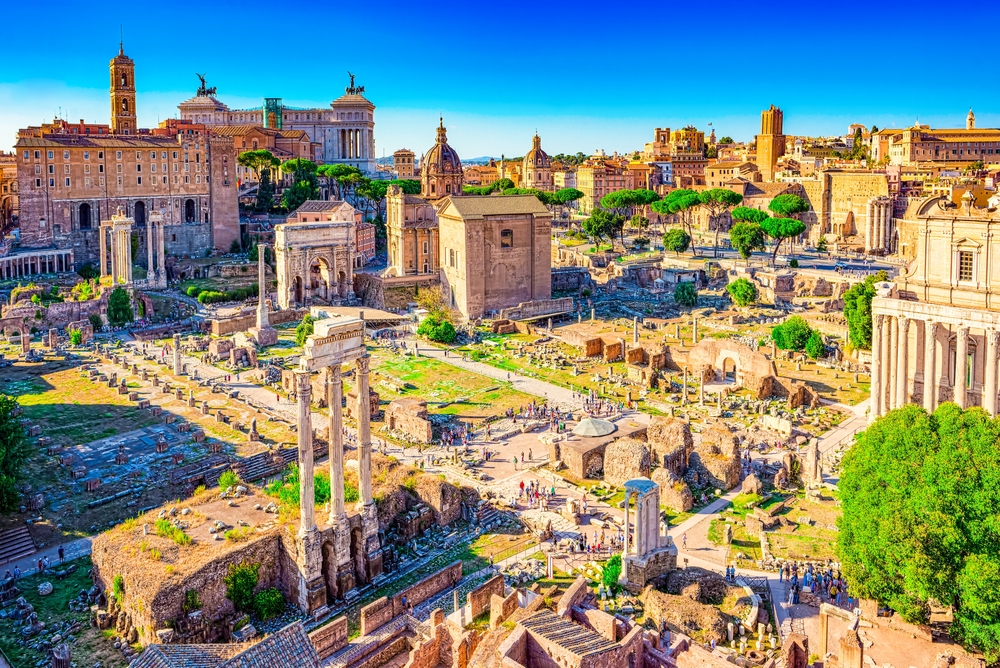
The Roman Forum and Palatine are the heart of ancient Rome, where political, religious, and social life once flourished. The Forum, a sprawling plaza surrounded by ruins of important government buildings, temples, and marketplaces, offers a glimpse into the epicentre of Roman civilisation. Adjacent to the Forum, Palatine Hill is the legendary birthplace of Rome, home to ancient palaces and stunning views over the city. You can explore the remnants of Rome's illustrious past and walk in the footsteps of emperors and citizens alike.
- Address: Foro Romano, Via Sacra entrance nearby Colosseum, 00186 Roma
3. Pantheon
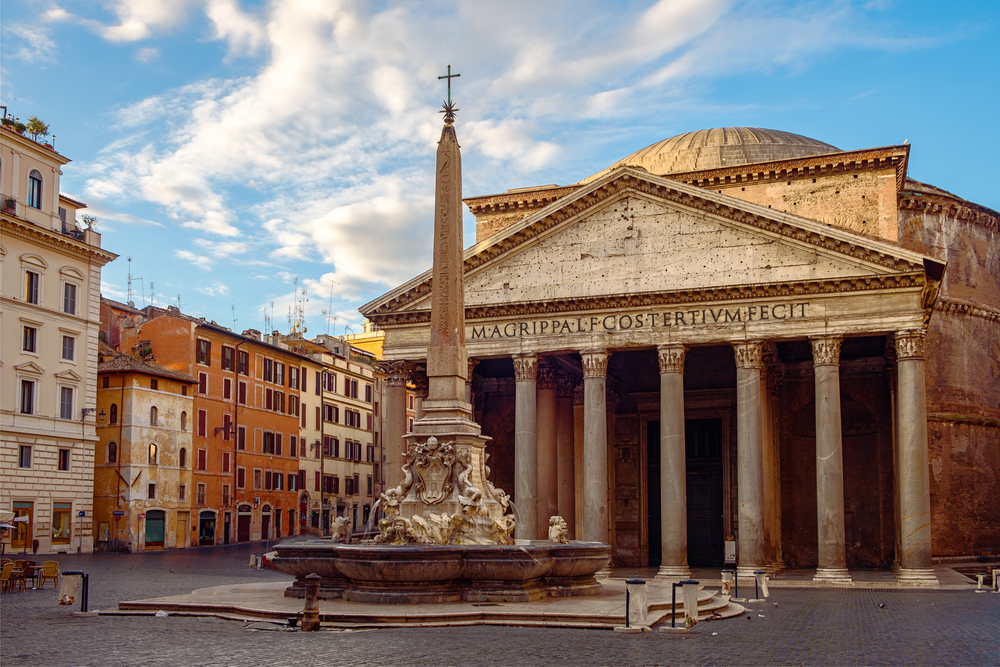
The Pantheon, an architectural masterpiece of ancient Rome, stands as one of the best-preserved monuments of its time. Originally built as a temple to all gods around 126 A.D., it was later converted into a Christian church with the name Basilica of Santa Maria Ad Martyres. The Pantheon's most striking feature is its massive dome, which remains the world's largest unreinforced concrete dome, with a central oculus that opens to the sky. You’ll be captivated by its harmonious proportions and the interplay of light and shadow within. The Pantheon remains a testament to Roman ingenuity and architectural prowess.
- Address: Pantheon, Piazza della Rotonda, 00186 Roma
4. Trevi Fountain

The Trevi Fountain, one of Rome's most iconic landmarks, is a stunning example of Baroque art and architecture. Completed in 1762, the fountain features a majestic sculpture of Neptune flanked by tritons and sea horses. Tradition holds that tossing a coin into the fountain ensures a return to Rome, making it a beloved ritual for visitors. So, toss a coin and make a wish, too. The Trevi Fountain's grandeur and intricate details make it a must-see attraction, especially when illuminated at night, casting a magical glow over the cascading waters.
- Address: Fontana di Trevi, Piazza di Trevi, 00187 Roma
5. Castel Sant’Angelo

Castel Sant'Angelo, originally built as Emperor Hadrian's mausoleum in 139 A.D., is a towering cylindrical fortress that has served various roles throughout history, including as a papal residence and a prison. Connected to Vatican City by the Passetto di Borgo, a secret passageway, the castle offers stunning views of Rome from its terrace. Inside, you can explore its museum, which showcases artefacts and historical exhibits. Castel Sant'Angelo's rich history and impressive architecture make it a captivating site for all who visit.
- Address: Museo Nazionale di Castel Sant'Angelo, Lungotevere Castello, 50, 00193 Roma
6. Piazza Navona
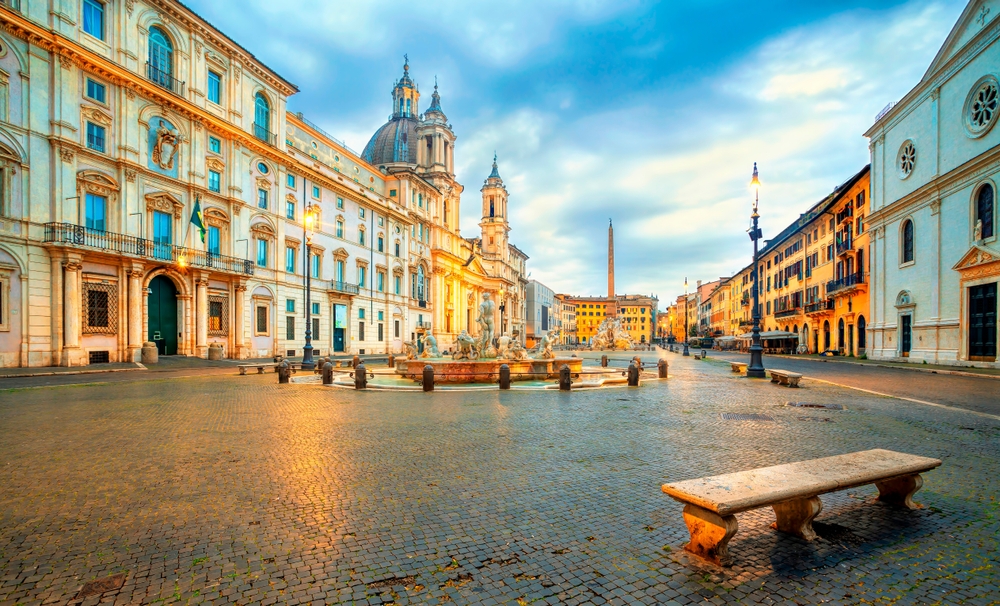
Piazza Navona, one of Rome's most famous squares, is a vibrant showcase of Baroque architecture and art. Built on the site of the ancient Stadium of Domitian, the remains of which you can visit, the piazza features three magnificent fountains, with the centrepiece being Bernini's Fountain of the Four Rivers. Other sights on the square are the 17th century Baroque church of Sant'Agnese in Agone and the neoclassical palace Palazzo Braschi from the 18th century, now serving as the Museum of Rome. Surrounded by charming cafes, restaurants, and historic buildings, Piazza Navona is a lively hub for locals and tourists alike. The square's bustling atmosphere, combined with its artistic and architectural beauty, makes it a must-visit destination in Rome.
- Address: Piazza Navona, 00186 Roma
7. Piazza di Spagna - Spanish Steps - Piazza della Trinità dei Monti

Piazza di Spagna, home to the famous Spanish Steps, is one of Rome's most iconic and picturesque locations. The 135-step staircase, built in the 18th century, leads up to the beautiful church of Trinità dei Monti offering stunning views of the city. At the base of the steps, Piazza di Spagna is adorned with the elegant Barcaccia Fountain, designed by Bernini. Worth a visit is the Keats-Shelley House, dedicated to the British Romantic poets who were fascinated by the Eternal City. Via dei Condotti and its parallel streets leading from the piazza are among the most popular destinations for shoppers.
- Address: Scalinata di Trinità dei Monti, Piazza di Spagna, 00187 Roma
8. Vatican Museums and Sistine Chapel

The Vatican Museums are among the most significant cultural and artistic treasures in the world. The Vatican Museums house an extensive collection of art and historical artefacts amassed by the Catholic Church over centuries, including masterpieces by Michelangelo, Raphael, and Leonardo da Vinci. The highlight of your visit will be the Sistine Chapel, renowned for Michelangelo's breathtaking ceiling frescoes and The Last Judgement on the altar wall. These works of art are considered some of the greatest achievements in Western art.
- Address: Musei Vaticani, Viale Vaticano, 00165 Roma

St. Peter’s Basilica, a masterpiece of Renaissance architecture, is one of the largest and most renowned churches in the world and stands as the spiritual heart of the Vatican and the Catholic Church. Construction began on April 18, 1506 and was completed on November 18, 1626. The basilica is home to stunning artworks such as Michelangelo's Pietà and Bernini's Baldachin. You must climb the magnificent dome which offers breathtaking views over Rome. As the burial site of St. Peter, one of Jesus’ apostles, holds immense religious significance and attracts millions of pilgrims and tourists each year.
- Address: Basilica Papale di San Pietro, Piazza San Pietro, 00120 Città del Vaticano
10. Galleria Borghese & Villa Borghese

Galleria and Villa Borghese form one of Rome's most enchanting cultural and recreational areas. The Galleria Borghese, housed in the Villa Borghese Pinciana, is a renowned art gallery showcasing masterpieces by artists such as Caravaggio, Bernini, and Raphael. Surrounded by the lush greenery of Villa Borghese gardens, the gallery offers a serene escape with beautifully landscaped gardens, walking paths, fountains, and sculptures. This combination of art and nature provides a perfect retreat for both art lovers and those seeking a peaceful respite from the bustling city.
- Address: Galleria Borghese, Piazzale Scipione Borghese, 5, 00197 Roma
11. Capitoline Hill & The Capitoline Museums
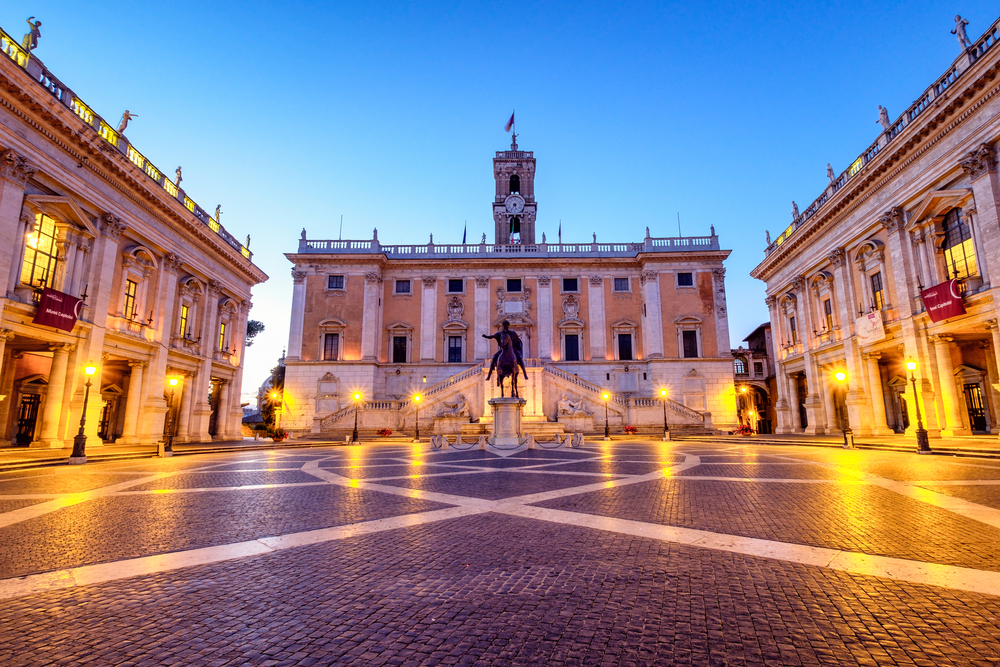
The Capitoline Hill is one of Rome's most historically significant and picturesque areas. It houses the Capitoline Museums, the world’s oldest public museums, featuring an extensive collection of art and artifacts from ancient Rome. Designed by Michelangelo, the museums display masterpieces such as the Capitoline Wolf, the equestrian statue of Marcus Aurelius and many more. The hill itself offers stunning views of the Roman Forum and the city, making it a must-visit destination for history enthusiasts and art lovers alike.
- Address: Piazza del Campidoglio, 1, 00186 Roma
12. Monument to Vittorio Emanuele II (Vittoriano) & Piazza Venezia
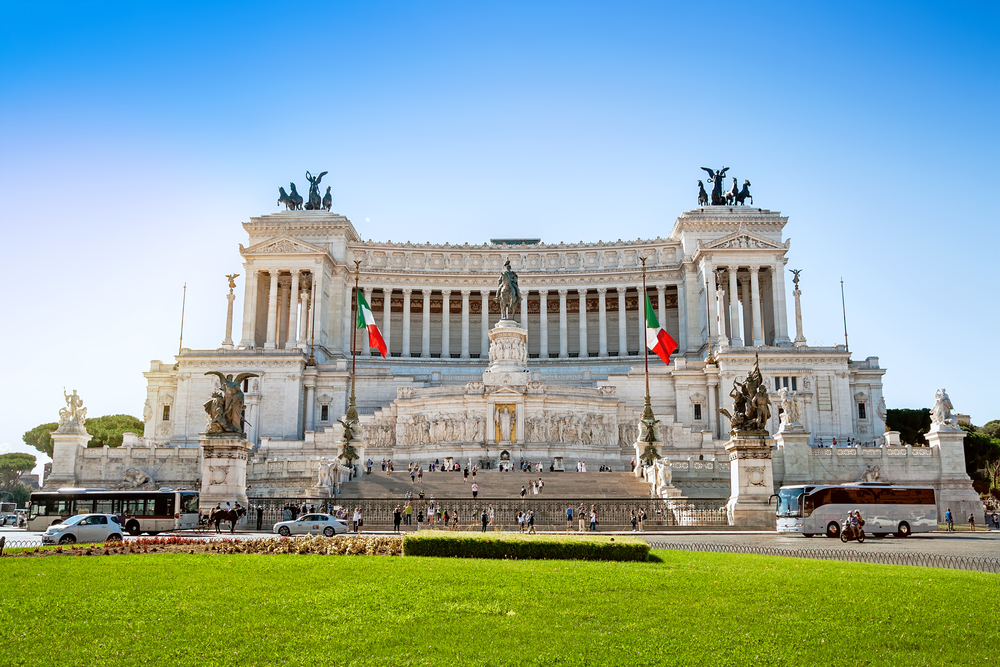
The Monument to Vittorio Emanuele II, commonly known as the Vittoriano, is a grand neoclassical monument in Piazza Venezia. Built to honour the first king of unified Italy, it features a majestic equestrian statue of Vittorio Emanuele II and an eternal flame at the Tomb of the Unknown Soldier. The monument's white marble structure is adorned with grand staircases, Corinthian columns, and fountains. Take the elevator to the monument's terrace and enjoy the spectacular views of the Eternal City. Piazza Venezia, located at the heart of Rome, serves as a bustling hub and a perfect starting point to explore the city's historical landmarks. Worth seeing is the National Museum of Palazzo Venezia with works of art from the 14th to the 16th centuries, including paintings, sculptures, tapestries, and decorative arts.
- Address: Monumento a Vittorio Emanuele II, Piazza Venezia, 00186 Roma
Ancient Roman Sites
Explore the timeless allure of Rome's ancient heritage. Step back in time and discover monumental ruins, grandiose structures, and the remnants of an empire that shaped the course of history. These ancient sites offer a fascinating glimpse into the architectural prowess and cultural achievements of one of the world's greatest civilizations.
13. Baths of Caracalla
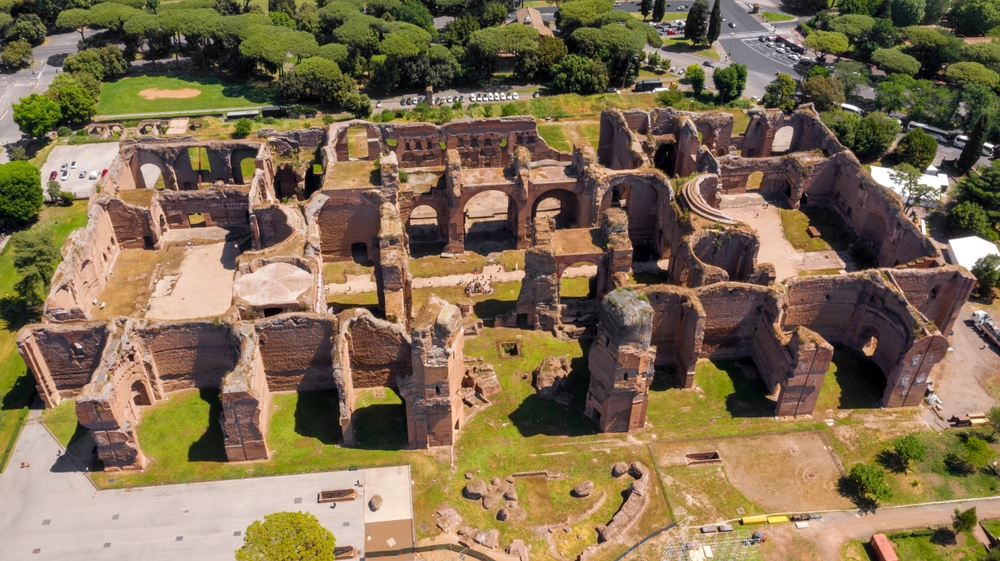
The Baths of Caracalla are ancient Roman public baths built between AD 212 and 216 during the reign of Emperor Caracalla. This sprawling complex once served as a luxurious retreat for Roman citizens, featuring hot and cold baths, gyms, libraries, and gardens. Despite its partial ruin, the Baths of Caracalla still showcase the grandeur of Roman engineering and architecture, with towering walls and intricate mosaic floors. Today, you can explore the remains of this monumental structure and imagine life in ancient Rome amidst its impressive ruins.
- Address: Terme di Caracalla, Viale delle Terme di Caracalla, 52, 00153 Roma
14. Circus Maximus
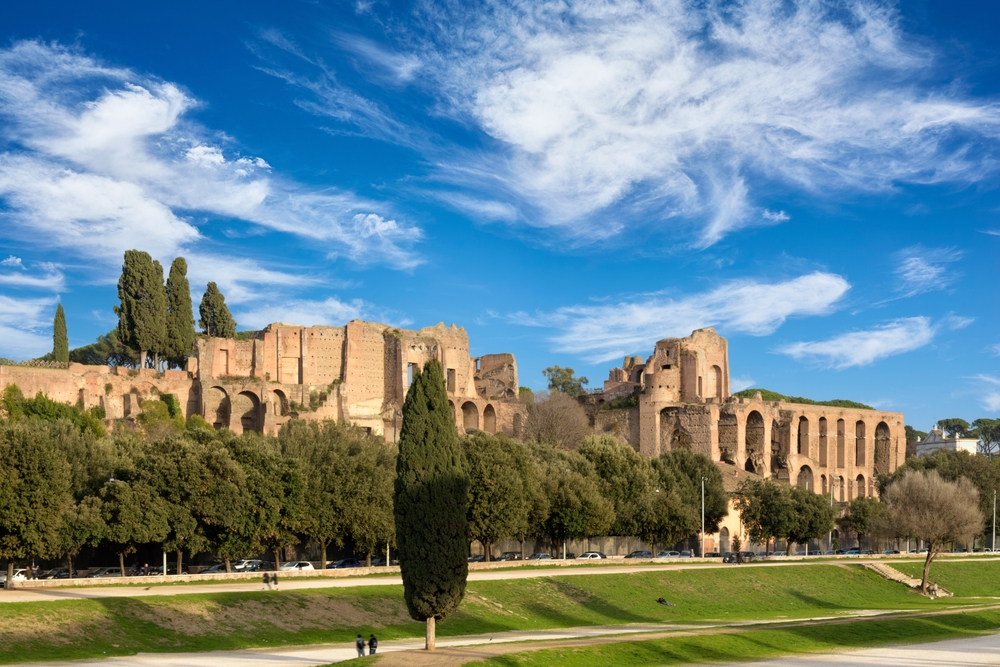
The Circus Maximus is an ancient Roman chariot racing stadium and mass entertainment venue located in the valley between the Palatine and Aventine Hills. With a capacity of over 150,000 spectators, it was the largest stadium in ancient Rome and hosted various events, including chariot races, religious ceremonies, and public gatherings. Today, the Circus Maximus is a vast archaeological site, marked by the outline of its ancient track and surrounding ruins. Explore the site, imagining the excitement and spectacle of ancient Roman life that once filled this historic arena.
- Address: Circo Massimo, Via del Circo Massimo, 00186 Roma
15. Arch of Constantine
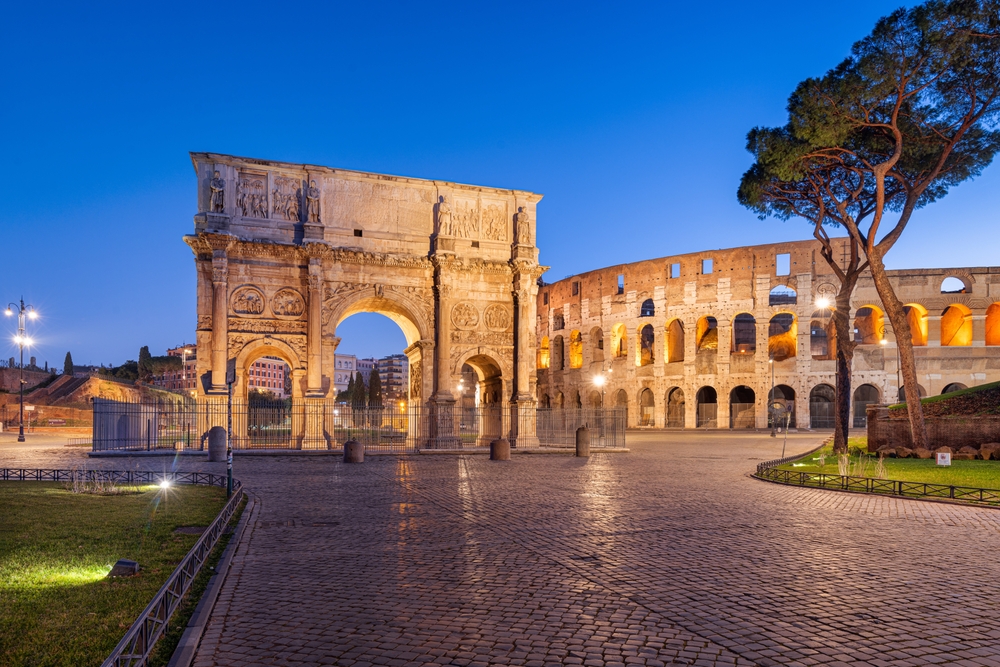
The Arch of Constantine is a triumphal arch on the southwest side of the Colosseum. Built in AD 315 to commemorate Emperor Constantine's victory over Maxentius at the Battle of Milvian Bridge, it is one of the largest and best-preserved Roman triumphal arches. The arch is adorned with intricate reliefs and sculptures, many of which were recycled from earlier monuments. Admire the arch's majestic structure and intricate details, while appreciating its historical significance as a symbol of imperial power and victory.
- Address: Arco di Costantino, Via di San Gregorio, 00186 Roma
16. Domus Aurea
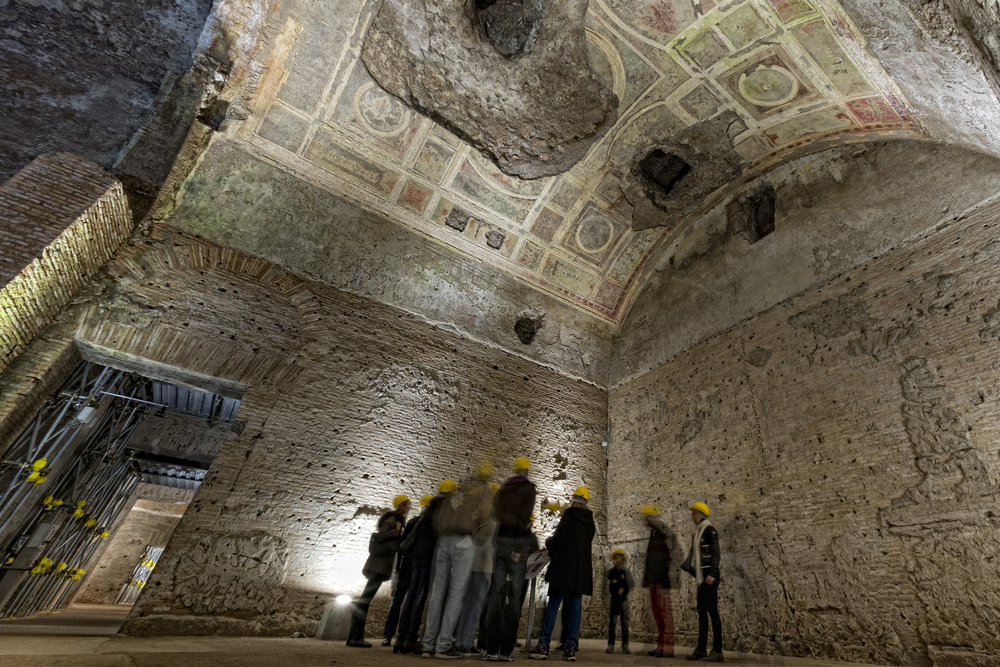
The Domus Aurea, meaning "Golden House" in Latin, was a vast and opulent palace complex built by the Roman Emperor Nero in the heart of ancient Rome. Constructed after the Great Fire of Rome in AD 64, it covered a vast area on the Palatine, Esquiline, and Caelian Hills. The palace was renowned for its extravagant decorations, including frescoes, stucco reliefs, and intricate architectural features. Today, visitors can explore the underground remains of the Domus Aurea, gaining insight into the lavish lifestyle of Nero and experiencing the innovative architectural techniques employed in its construction.
- Address: Via della Domus Aurea, 1, 00184 Roma
17. Imperial Forums
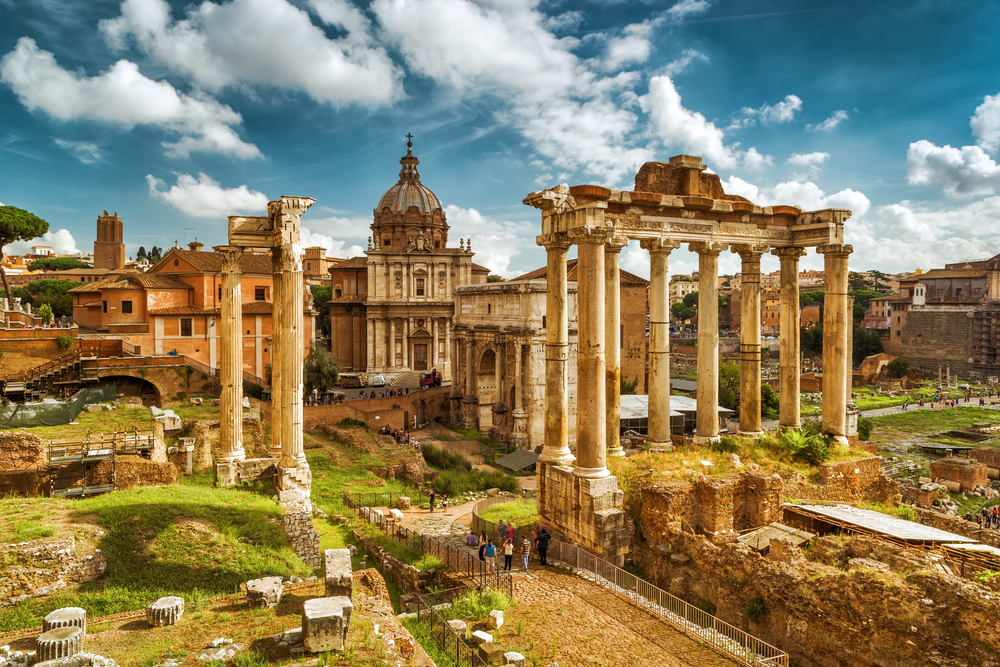
The Imperial Forums are a series of monumental public squares and forums built between 46 B.C. and 113 A.D. in ancient Rome. These forums were the center of political, religious, and social life in the Roman Empire and were adorned with grand temples, basilicas, and government buildings. Each forum was dedicated to a specific emperor or aspect of Roman life, such as the Forum of Caesar, and the Trajan's Markets with the Museum of the Imperial Forums. Explore the ruins of these once magnificent complexes, marveling at their architectural splendor and historical significance.
- Address: Fori Imperiali, Via dei Fori Imperiali, 00186 Roma
18. Appian Way
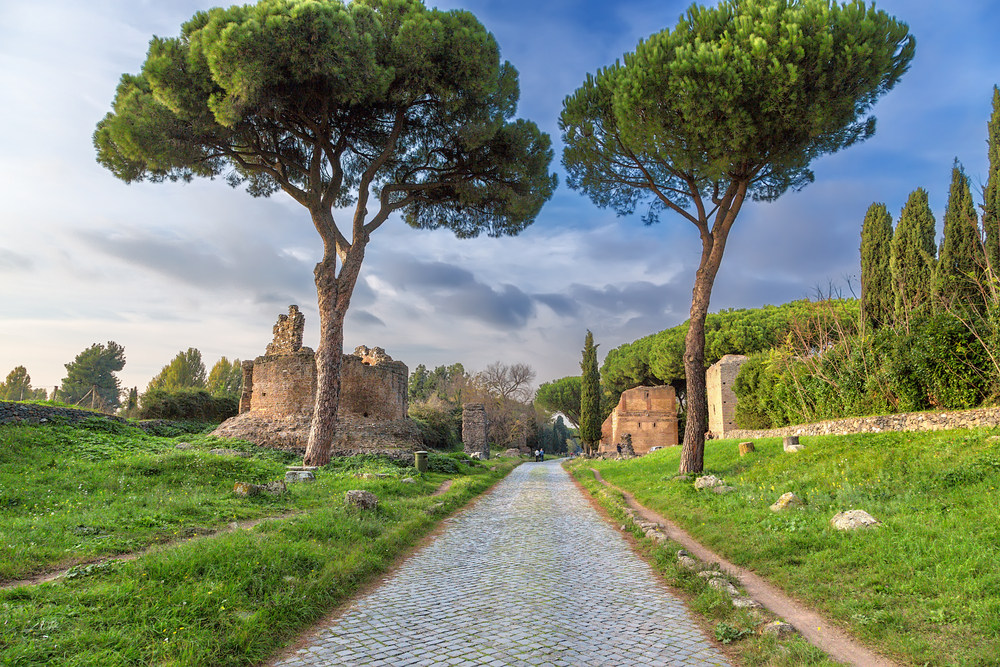
The Appian Way is one of the most important and oldest Roman roads, extending from Rome to Brindisi in southeastern Italy. Built in 312 B.C., it served as a vital artery for trade, communication, and military movement in the Roman Empire. Lined with tombs, mausoleums, and ancient ruins, the Appian Way offers a fascinating glimpse into ancient Roman life and history. The three catacombs St. Callixtus, and Domitilla are among the most visited places on the ancient route. Today, you can walk or cycle along sections of the ancient road, exploring its archaeological sites and enjoying the scenic countryside views.
- Address: Centro Servizi Appia Antica, Via Appia Antica, 58-60, 00179 Roma
19. Crypt of the Capuchins
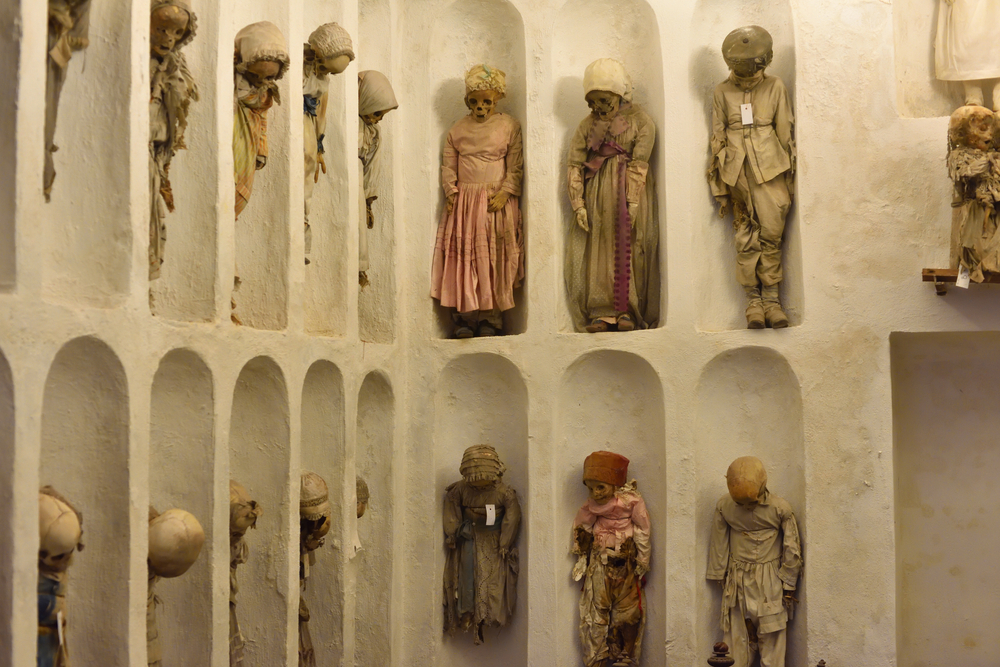
The Crypt of the Capuchins is a unique and macabre site located beneath the Church of Santa Maria della Concezione dei Cappuccini in Rome. This crypt is adorned with the bones of approximately 3500 Capuchin friars, artistically arranged in intricate patterns and designs across several small chapels. The crypt serves as a memento mori, reminding visitors of the fleeting nature of life. It offers a fascinating, if eerie, glimpse into the Capuchin order’s approach to mortality and religious devotion.
- Address: Museo e Cripta dei Frati Cappuccini, Via Vittorio Veneto, 27, 00187 Roma
20. Largo di Torre Argentina
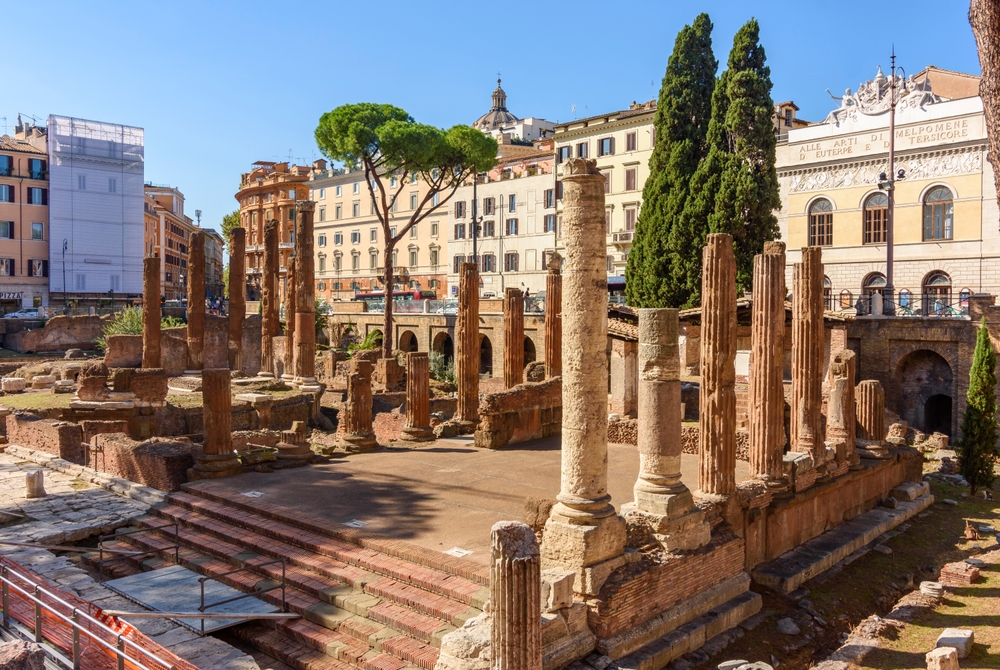
Largo di Torre Argentina is an ancient square in Rome that houses the remains of four Republican Roman temples and the Theatre of Pompey, where Julius Caesar was famously assassinated in 44 BC. The site is also known for its large population of stray cats, cared for by a local cat sanctuary. Explore the fascinating ruins and reflect on the historical significance of this site, which offers a unique glimpse into the city's ancient past amidst the bustle of modern Rome.
- Address: Area Sacra di Largo Argentina, 00186 Roma
Museums and Galleries
Immerse yourself in Rome's rich artistic and cultural heritage through its museums and galleries. Housing vast collections of masterpieces, these institutions showcase works from antiquity to contemporary art. Each visit offers a journey through history, creativity, and innovation, highlighting the city's enduring influence on the world of art and culture.
21. Galleria Doria Pamphilj
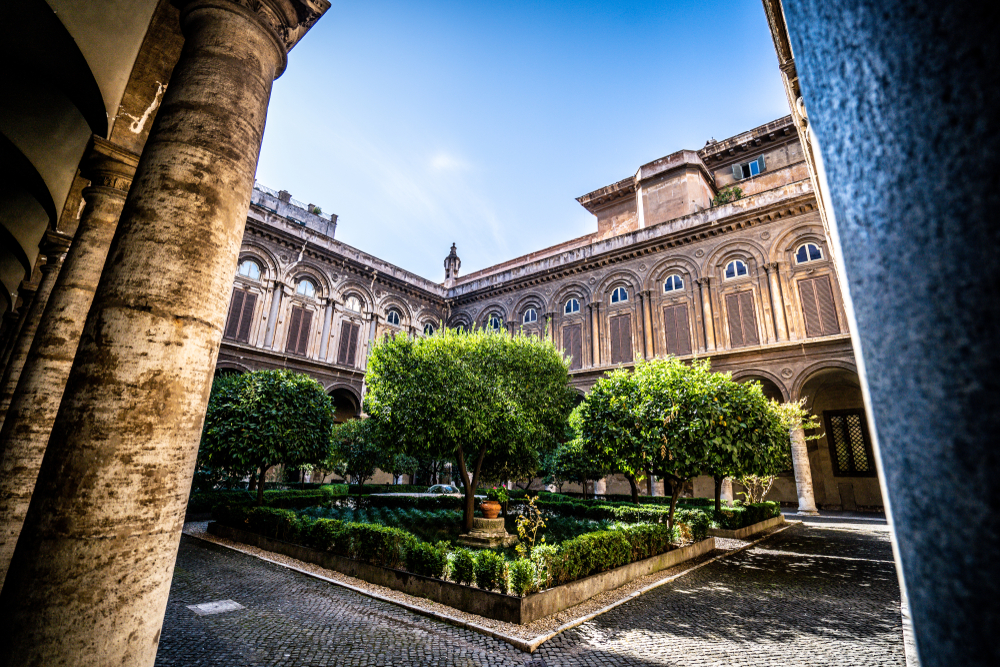
Galleria Doria Pamphilj is a prestigious private art gallery housed in the historic Palazzo of the same name. The gallery boasts an impressive collection of art amassed by the Pamphilj family over centuries, including masterpieces by Caravaggio, Velázquez, Titian, and Raphael. Wander through the opulent rooms adorned with exquisite furnishings and artworks, experiencing the grandeur of a noble Roman residence. The Gallery's highlight is Velázquez's renowned portrait of Pope Innocent X, a masterpiece of Baroque portraiture.
- Address: Galleria Doria Pamphilj, Via del Corso, 305, 00186 Roma
22. National Roman Museum (Baths of Diocletian/Palazzo Massimo Alle Terme/Palazzo Altemps/Crypta Balbi)
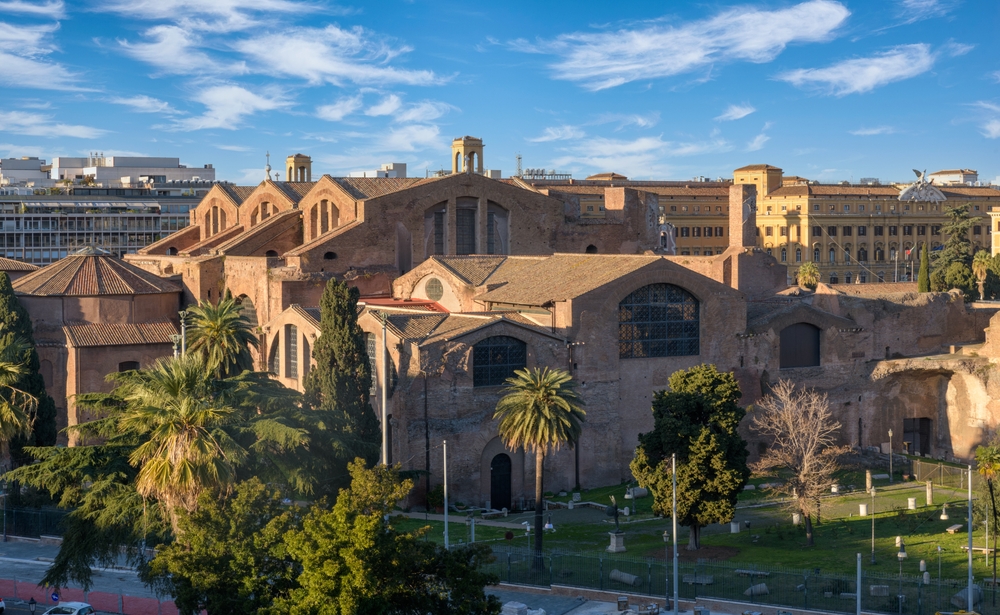
The National Roman Museum (Museo Nazionale Romano) is one of the most important cultural institutions in Rome, comprising four distinct sites:
- Baths of Diocletian: Once the largest public baths in ancient Rome, this site now houses an extensive collection of ancient artifacts, including sculptures, inscriptions, and tombs, amidst the ruins of the grand bath complex.
Address: Terme di Diocleziano, Viale Enrico de Nicola, 79, 00185 Roma - Palazzo Massimo Alle Terme: This museum features a vast array of Roman art, including frescoes, mosaics, statues, and coin collections. Highlights include the famous Boxer at Rest and the stunning frescoes from the Villa of Livia.
Address: Palazzo Massimo Alle Terme, Largo di Villa Peretti, 2, 00185 Roma- Palazzo Altemps: Located near Piazza Navona , this Renaissance palace displays classical sculptures and antiquities collected by noble Roman families, including the renowned Ludovisi Throne and the Galatian Suicide.
Address: Palazzo Altemps, Piazza di Sant'Apollinare, 46, 00186 Roma - Crypta Balbi: This museum offers a unique look into the urban development of Rome through the centuries, displaying artifacts discovered in excavations of the ancient Roman theater and its surroundings.
Address: Crypta Balbi, Via delle Botteghe Oscure, 31, 00186 Rom
- Palazzo Altemps: Located near Piazza Navona , this Renaissance palace displays classical sculptures and antiquities collected by noble Roman families, including the renowned Ludovisi Throne and the Galatian Suicide.
23. MAXXI (National Museum of the 21st Century Arts)
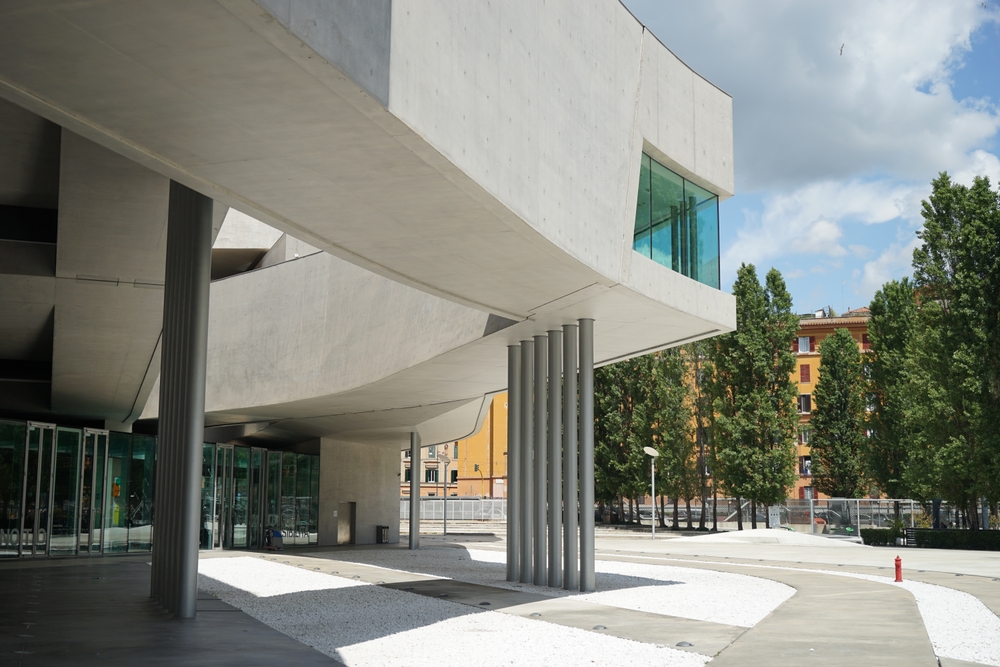
MAXXI, the National Museum of 21st Century Arts, is a cutting-edge contemporary art and architecture museum located in Rome. Designed by renowned architect Zaha Hadid, MAXXI features innovative and dynamic spaces that host a wide array of exhibitions, performances, and events. The museum's collection includes contemporary art, photography, and architectural works by both Italian and international artists. MAXXI is a hub for creativity and modern culture, providing visitors with a unique and engaging experience.
24. National Gallery of Ancient Art & Palazzo Barberini & Galleria Corsini
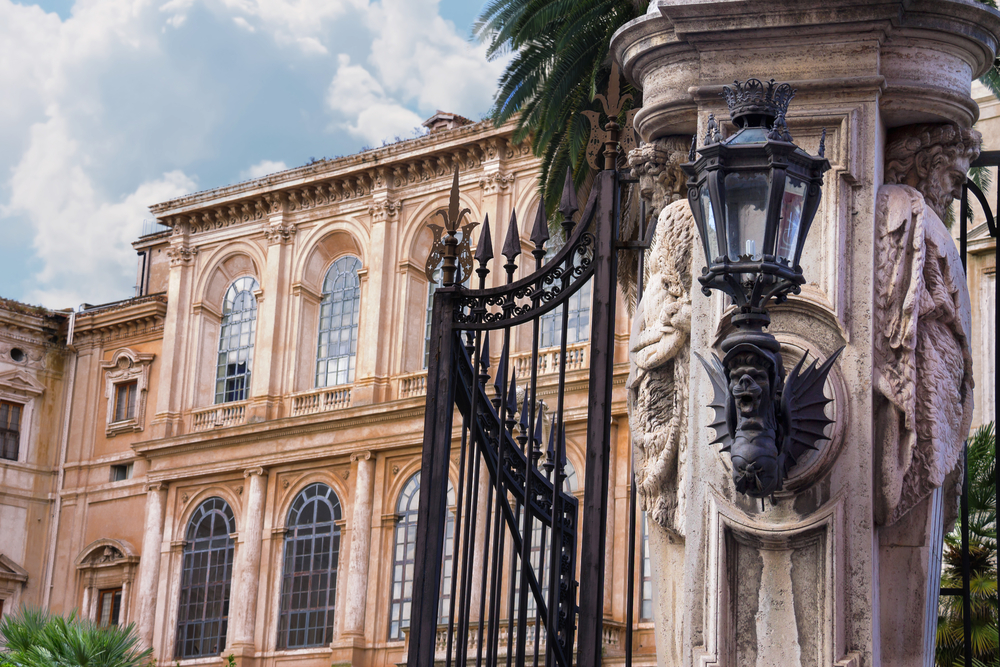
The National Gallery of Ancient Art in Rome is divided between two magnificent sites: Palazzo Barberini and Galleria Corsini.
Palazzo Barberini
An exquisite Baroque palace, Palazzo Barberini houses a vast collection of Italian and European art from the 13th to the 18th centuries. Highlights include masterpieces by Caravaggio, Raphael, Titian, and Holbein. The palace itself is a work of art, featuring grand staircases, stunning frescoes, and elegant rooms designed by renowned architects like Bernini and Borromini.
Address: Palazzo Barberini, Via delle Quattro Fontane, 13, 00184 Roma
Galleria Corsini
Located in the historic Palazzo Corsini, this gallery offers a more intimate setting to view an impressive collection of Renaissance and Baroque art. The collection includes works by Caravaggio, Rubens, Guido Reni, and Fra Angelico. The gallery also features fine examples of 17th and 18th-century Roman and Neapolitan art, alongside the beautiful architecture and decor of the palazzo.
Address: Galleria Corsini, Via della Lungara, 10, 00165 Roma
25. Palazzo & Galleria Colonna
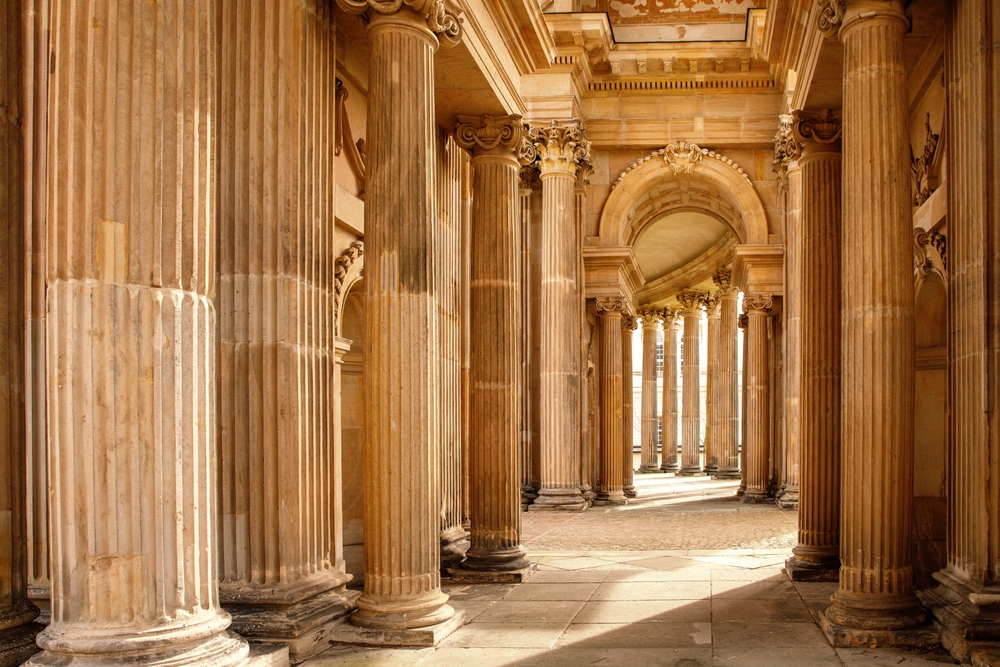
Palazzo Colonna, one of Rome's largest and oldest private palaces, is home to the magnificent Galleria Colonna. The gallery showcases an extraordinary collection of Baroque art and furnishings accumulated by the Colonna family over centuries. Highlights include masterpieces by artists such as Brueghel, Tintoretto, and Guercino. The grand halls and rooms of the gallery are adorned with stunning frescoes, intricate stuccoes, and luxurious decorations, providing a captivating glimpse into the opulent lifestyle of Roman nobility.
- Address: Palazzo Colonna, Via della Pilotta, 17, 00187 Roma
26. Museo di Roma a Palazzo Braschi
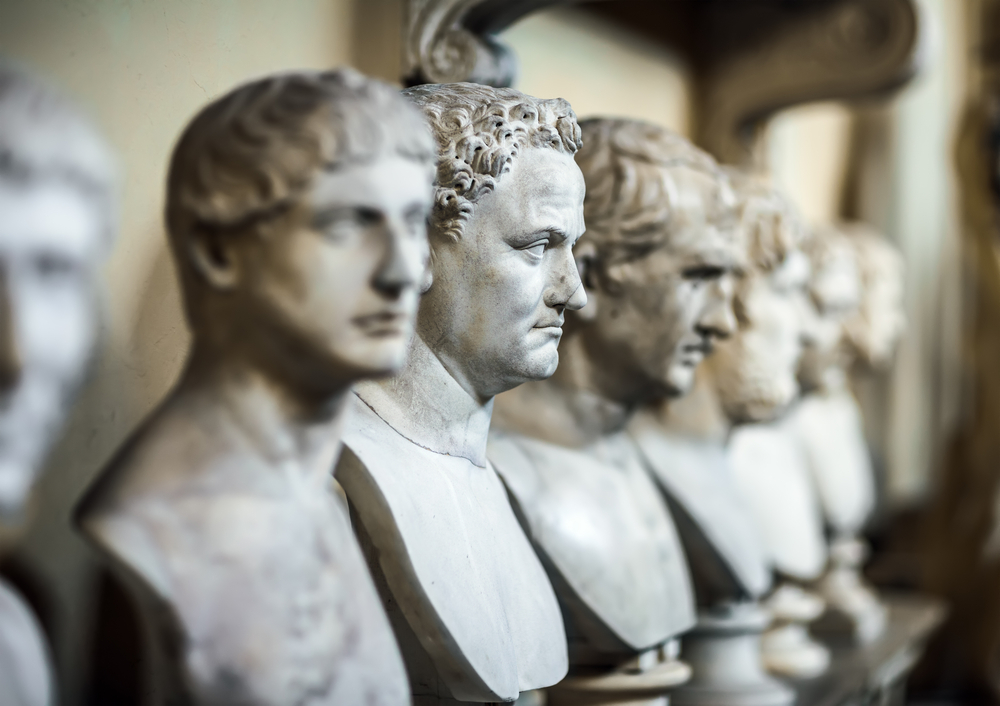
Museo di Roma, located in the historic Palazzo Braschi, offers an extensive collection that chronicles the history and culture of Rome from the Middle Ages to the early 20th century. The museum's exhibits include paintings, sculptures, photographs, and artefacts that depict various aspects of Roman life, art, and architecture. The elegant Palazzo Braschi itself features beautifully frescoed rooms and a stunning staircase, enhancing your experience with its architectural grandeur.
- Address: Museo di Roma a Palazzo Braschi, Piazza di San Pantaleo, 10, Piazza Navona, 2, 00186 Roma
27. Galleria Spada
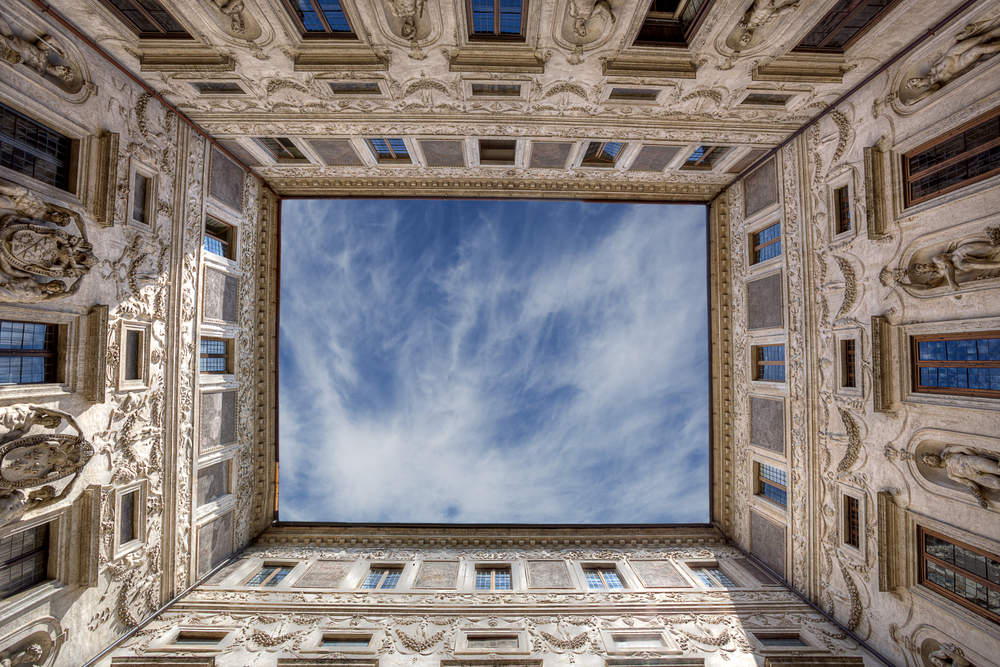
Located in Palazzo Spada, Galleria Spada is a small yet remarkable art gallery, renowned for its stunning architecture and collection of Baroque art. Admire works by artists such as Caravaggio, Titian, and Guido Reni. However, the highlight of Galleria Spada is its optical illusion created by Francesco Borromini. The gallery's perspective gallery, a long corridor with diminishing columns and a false perspective, creates the illusion of depth, making it appear much longer than it actually is. This architectural marvel adds an extra layer of intrigue to the gallery experience.
- Address: Galleria Spada, Piazza Capo di Ferro, 13, 00186 Roma
28. Centrale Montemartini
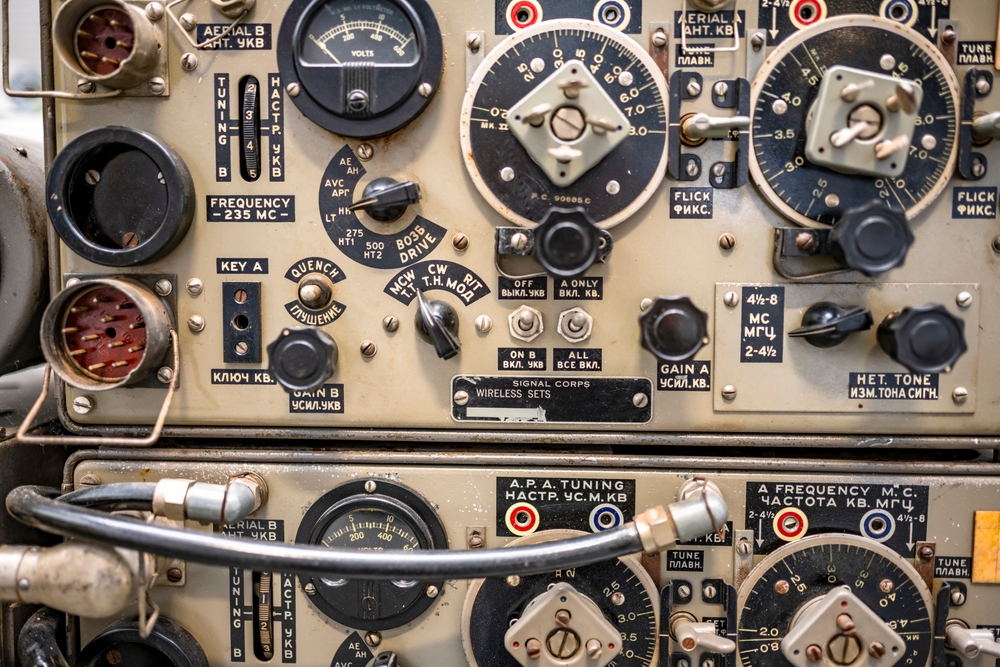
Housed in a former power plant, Centrale Montemartini is a unique museum that combines classical art with industrial archaeology. It displays ancient Roman sculptures and artefacts amidst the backdrop of early 20th-century machinery. This striking contrast creates a fascinating juxtaposition between the ancient and the modern, making Centrale Montemartini a distinctive cultural experience. Highlights include statues from the Capitoline Museums' collection, intricate mosaics, and beautifully preserved frescoes.
- Address: Centrale Montemartini, Via Ostiense, 106, 00154 Roma
29. National Etruscan Museum of Villa Giulia
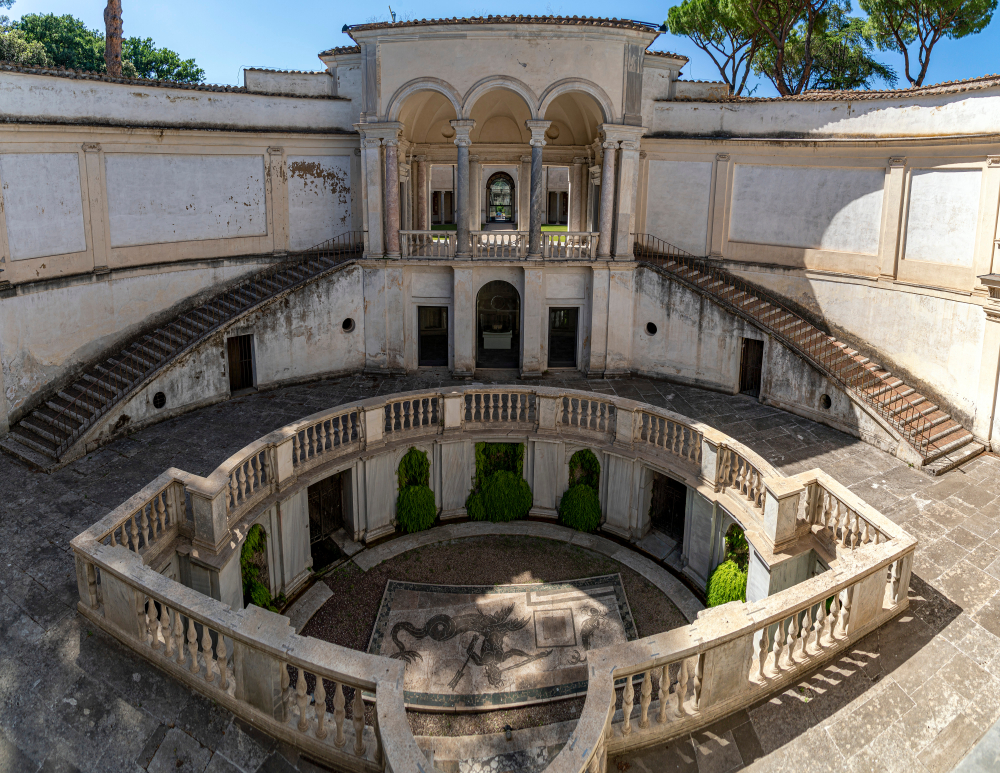
Housed in the magnificent Renaissance Villa Giulia, the National Etruscan Museum is dedicated to the ancient Etruscan civilization. The museum's extensive collection includes artefacts such as pottery, jewellery, sculptures, and funerary items, providing insights into the culture, religion, and daily life of the Etruscans. Highlights of the museum include the famous Sarcophagus of the Spouses, intricate bronze sculptures, and the reconstructed Tomb of the Reliefs. Surrounded by beautiful gardens, Villa Giulia offers a serene setting to explore the rich heritage of one of Italy's oldest civilizations.
- Address: National Etruscan Museum of Villa Giulia, Piazzale di Villa Giulia, 9, 00196 Roma
30. Central Museum of the Risorgimento
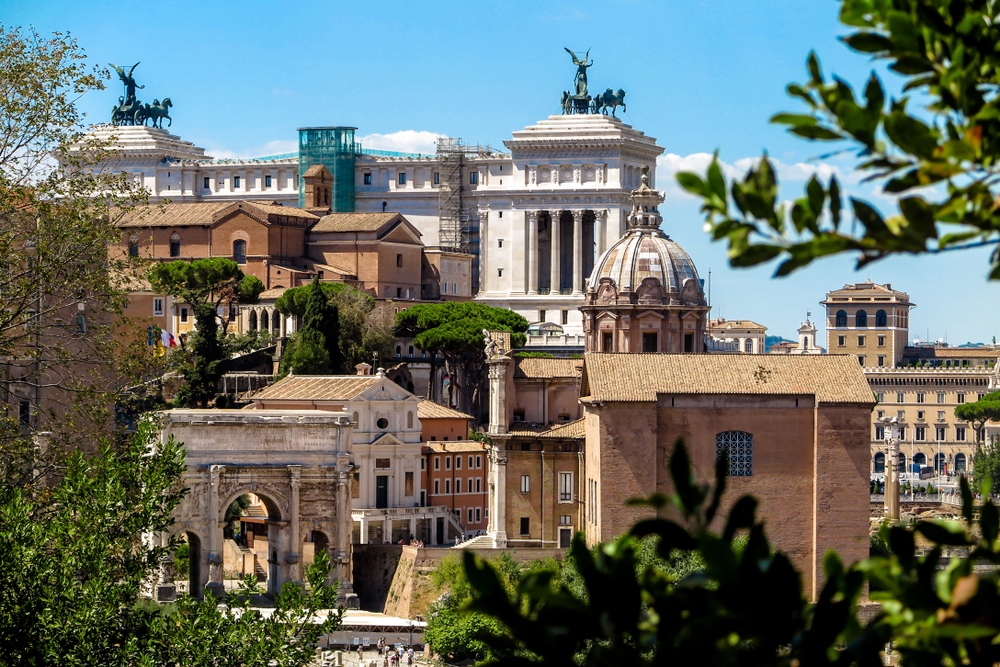
The Central Museum of the Risorgimento is dedicated to the history of the Italian Risorgimento, the period of Italian unification in the 19th century. The museum's collection includes artefacts, documents, paintings, and memorabilia related to key events and figures of the Risorgimento movement, such as Giuseppe Garibaldi and Count Camillo di Cavour. Explore the struggles and triumphs of this pivotal period in Italian history through immersive exhibits and multimedia presentations. The Museum of the Risorgimento offers valuable insights into the nation-building process and the fight for Italian independence and unity.
- Address: Museo Centrale del Risorgimento, Via di San Pietro in Carcere, 1, 00186 Roma
31. National Museum of Palazzo Venezia
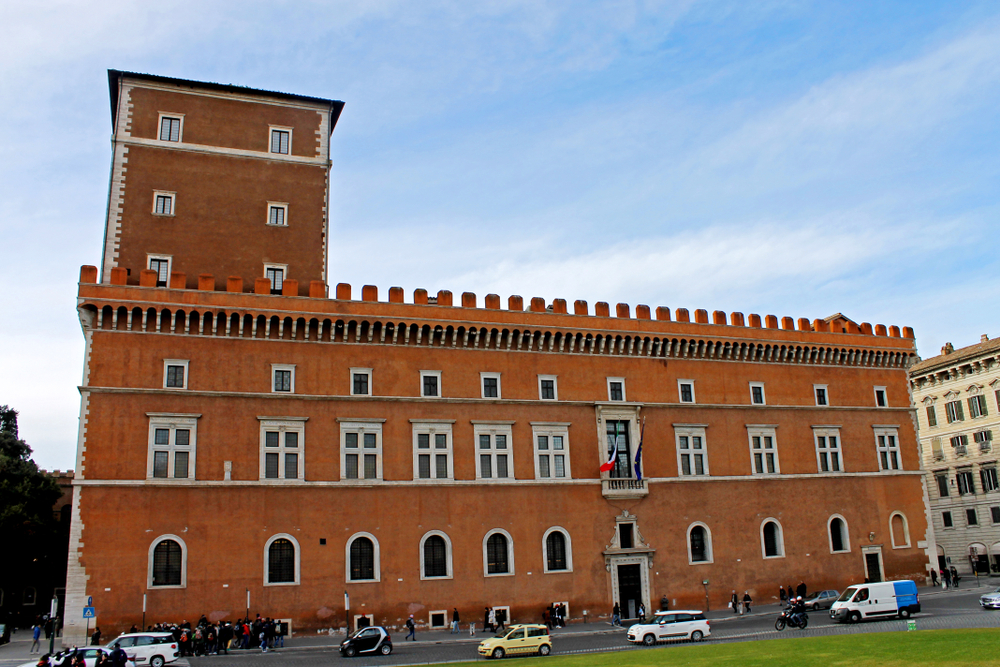
Housed in the historic Palazzo Venezia, this museum offers a rich collection of art and artefacts spanning various periods of Italian history. The museum's exhibits include Renaissance and Baroque sculptures, mediaeval ceramics, and a vast array of decorative arts. Explore the palazzo's rich history, as it served as the papal residence during the Renaissance and later became the Embassy of the Republic of Venice, hence its name. The museum provides a fascinating journey through Italy's cultural heritage within the grandeur of one of Rome's most iconic palaces.
- Address: Museo Nazionale del Palazzo Venezia, Via del Plebiscito, 118, 00186 Roma
Churches
Discover the spiritual and architectural splendor of Rome's churches. These sacred spaces, ranging from ancient basilicas to Baroque masterpieces, are adorned with stunning frescoes, intricate mosaics, and awe-inspiring sculptures. Each church offers a unique glimpse into the city's profound religious heritage and artistic achievements.
32. Archbasilica of Saint John Lateran
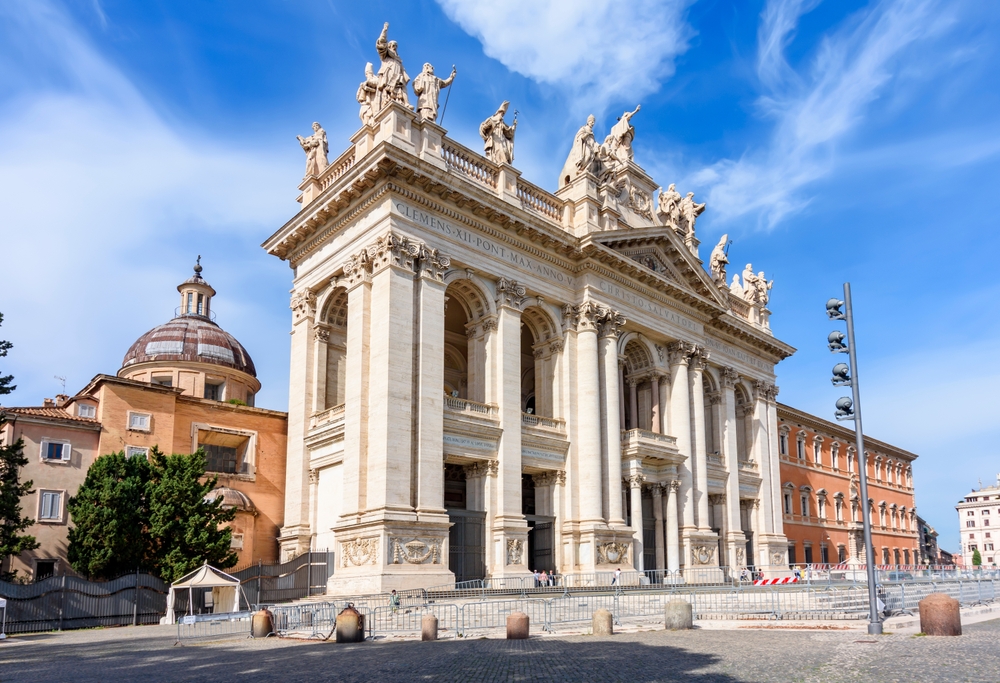
The Archbasilica of Saint John Lateran is one of the four major papal basilicas in Rome and holds the title of "Archbasilica" and "Mother of All Churches." This magnificent cathedral, dedicated to Saint John the Baptist and Saint John the Evangelist, is considered the oldest and most important church in the Western world. The basilica boasts stunning Baroque and Renaissance architecture, adorned with beautiful frescoes, mosaics, and sculptures. Admire the grandeur of the nave, the ornate baldachin over the high altar, and the papal throne.
The Baptistery of the Archbasilica was the very first of its kind in Rome and became the model for others throughout Italy. The Scala Sancta or Holy Stairs opposite the basilica, are believed to be the same steps that Jesus climbed during his Passion in Jerusalem. Pilgrims ascend these sacred stairs on their knees as an act of devotion. The Sancta Sanctorum or Holy of Holies at the top of the stairs houses precious relics and artefacts, including the wooden table traditionally believed to be the one used by Saint Peter for celebrating Mass. It remains a place of reverence and pilgrimage for devout Catholics.
- Address: Arcibasilica Papale di San Giovanni in Laterano, Piazza di San Giovanni in Laterano, 4, 00184 Roma
33. Basilica of Saint Mary Major
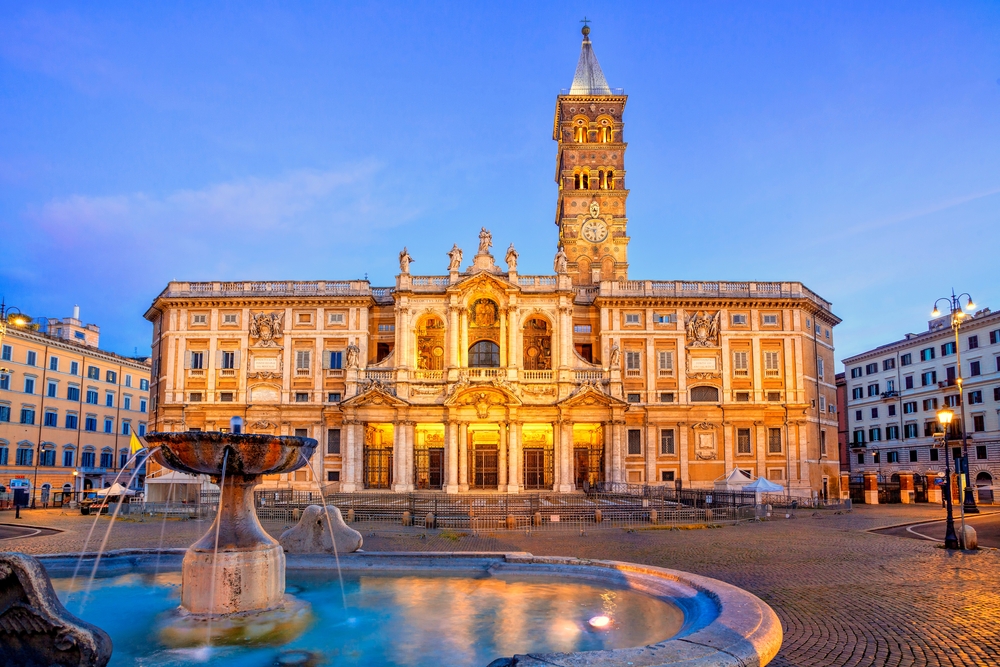
The Basilica of Saint Mary Major is one of the four papal basilicas in Rome and is renowned for its rich history, stunning architecture, and religious significance. According to tradition, the basilica was built in the 4th century after the Virgin Mary appeared in a dream to Pope Liberius, instructing him to build a church at the site where snow would fall on the following morning. The basilica's interior is adorned with exquisite mosaics, marble columns, and intricate decorations, while its exterior features a majestic Renaissance facade. Marvel at the ancient relics, chapels, and artwork housed within this magnificent basilica, which stands as a testament to centuries of devotion and faith.
- Address: Basilica Papale di Santa Maria Maggiore, Piazza di Santa Maria Maggiore, 42, 00185 Roma
34. Basilica of Saint Paul Outside the Walls
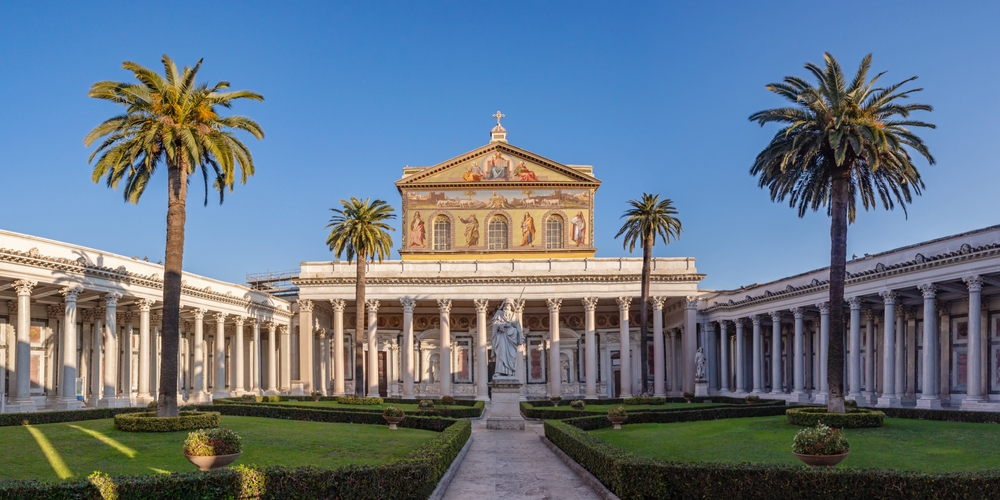
The Basilica of Saint Paul Outside the Walls is one of the four major basilicas and one of the seven pilgrimage churches of Rome. This ancient basilica, dedicated to Saint Paul the Apostle, is situated outside the Aurelian Walls, hence its name. Originally founded in the 4th century, the basilica has undergone several reconstructions over the centuries due to fires and earthquakes. The current structure, built in the 19th century, is an impressive example of Romanesque architecture with its majestic facade and grand interior. The basilica houses the tomb of Saint Paul, along with magnificent mosaics, frescoes, and marble columns. You can also explore the adjacent cloister and ancient Roman sarcophagi in the basilica's courtyard.
- Address: Basilica Papale di San Paolo Fuori le Mura, Piazzale San Paolo, 1a, 00146 Roma
35. Basilica of Santa Maria del Popolo

The Parish Basilica of Santa Maria del Popolo is a magnificent church renowned for its rich history and stunning artwork. Built in the 15th century, the basilica houses remarkable masterpieces by renowned artists such as Caravaggio, Raphael, Bernini, and Pinturicchio. Highlights include Caravaggio's "The Conversion of Saint Paul" and "The Crucifixion of Saint Peter," as well as Raphael's "Chigi Chapel." The church's elegant Renaissance and Baroque architecture, adorned with marble columns, intricate chapels, and beautiful altarpieces, provides a captivating setting for you to explore and admire.
- Address: Basilica Parrocchiale di Santa Maria del Popolo, Piazza del Popolo, 12, 00187 Roma
36. Basilica of Santa Maria in Trastevere
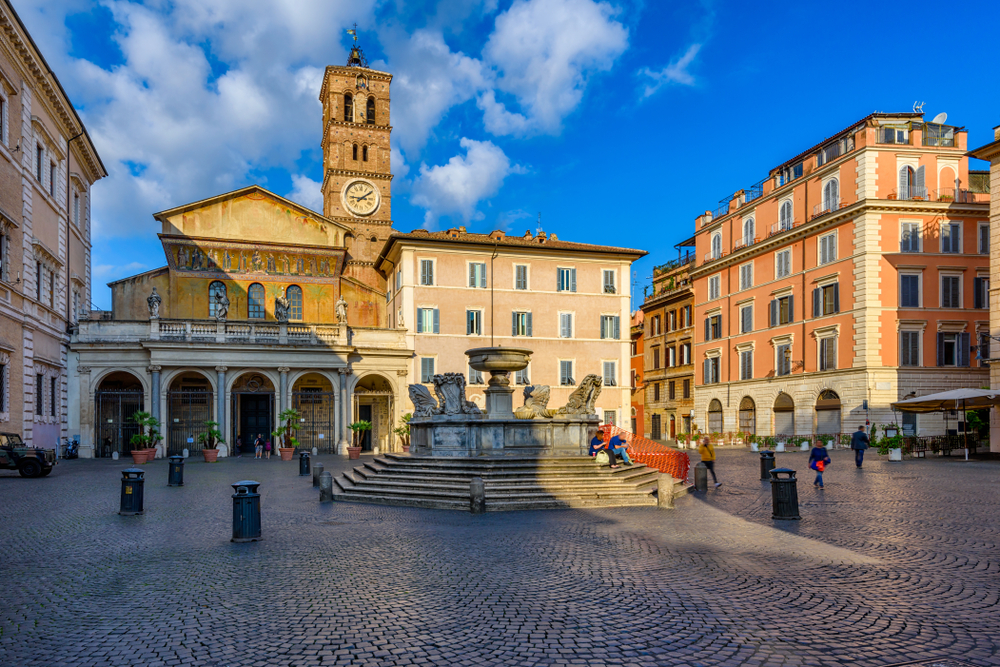
The Basilica of Santa Maria in Trastevere, one of Rome's oldest churches, holds a special place in the city's religious and cultural heritage. Dating back to the 4th century, this stunning basilica is dedicated to the Virgin Mary and is renowned for its beautiful mosaics, mediaeval architecture, and serene atmosphere. The interior of the church is adorned with magnificent Byzantine-style mosaics depicting scenes from the life of the Virgin Mary and other biblical narratives. You can also admire the impressive 12th-century campanile and the intricately decorated Baroque ceiling.
- Address: Basilica di Santa Maria in Trastevere, Piazza di Santa Maria in Trastevere, 00153 Roma
37. Basilica of Santa Maria in Cosmedin & the Mouth of Truth (Bocca della Verità)
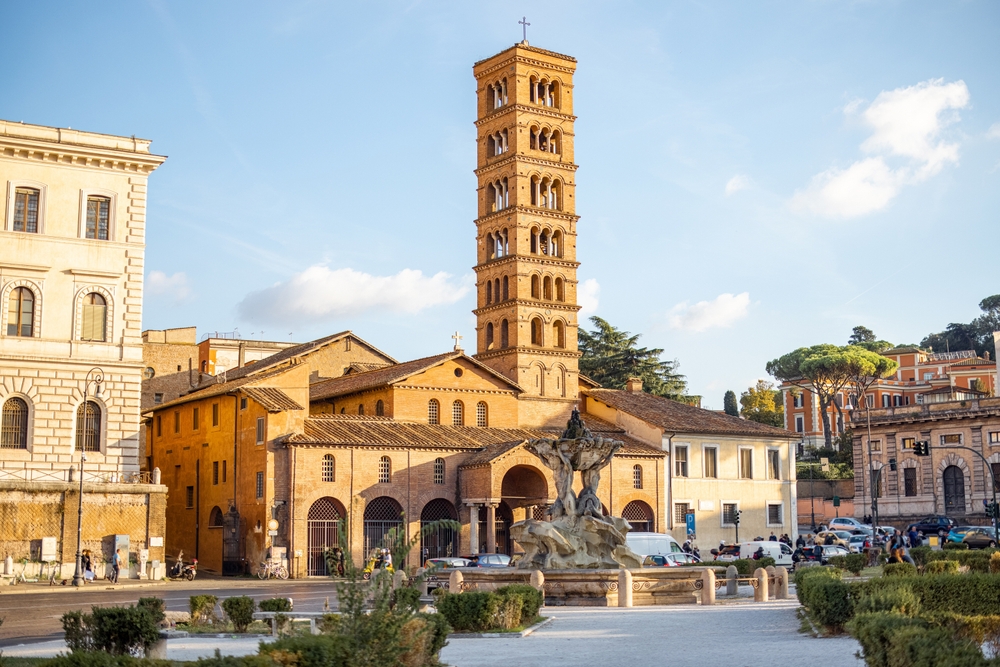
The Basilica of Santa Maria in Cosmedin, nestled in the ancient Forum Boarium, is a charming church steeped in history and legend. Dating back to the 6th century, this Byzantine-style basilica is known for its distinctive bell tower and portico adorned with classical columns. However, it is perhaps most famous for housing the Bocca della Verità (Mouth of Truth), an ancient marble mask with a hole for a mouth. Legend has it that it would bite off the hand of anyone who told a lie. Take a risk and put your hand in the mouth of this marble mask and see if it exposes you as a liar.
- Address: Basilica di Santa Maria in Cosmedin, Piazza della Bocca della Verità, 18, 00186 Roma
38. Church of St. Ignatius of Loyola

This stunning Baroque church is dedicated to Saint Ignatius of Loyola, the founder of the Jesuit order. Designed by renowned architect Filippo Raguzzini in the 17th century, the church is known for its magnificent interior, particularly its impressive ceiling frescoes by Andrea Pozzo. These trompe-l'oeil paintings create the illusion of a dome, despite the church's lack of one. You can also admire the lavish decorations, intricate marble altars, and beautiful chapels dedicated to various saints.
- Address: Chiesa di Sant'Ignazio di Loyola in Campo Marzio, Piazza S. Ignazio, 00186 Roma
Viewpoints
As mentioned earlier, you can enjoy spectacular views of Rome from the dome of St. Peter's Basilica, the terraces of the Monument to Vittorio Emanuele II (Vittoriano), and Castel Sant'Angelo, as well as from the Palatine and Capitoline Hills. Here, we’ll introduce you to other equally wonderful viewpoints that offer breathtaking perspectives of the Eternal City.
39. Janiculum Hill

The Janiculum Hill, also known as the Belvedere del Gianicolo, offers one of the most spectacular panoramic views of Rome. Located just above Trastevere, this vantage point provides sweeping vistas of the city's iconic landmarks, including St. Peter's Basilica, the Pantheon, and the Colosseum. The hill is also home to several notable monuments, such as the statue of Giuseppe Garibaldi and the equestrian statue of Anita Garibaldi. Each day at noon, visitors can experience the traditional firing of the cannon, a practice dating back to the 19th century. The Belvedere del Gianicolo is a must-visit spot for anyone looking to capture the breathtaking beauty of Rome from above.
- Address: Belvedere del Gianicolo, Piazzale Giuseppe Garibaldi, 00165 Roma
40. Pincio Terrace
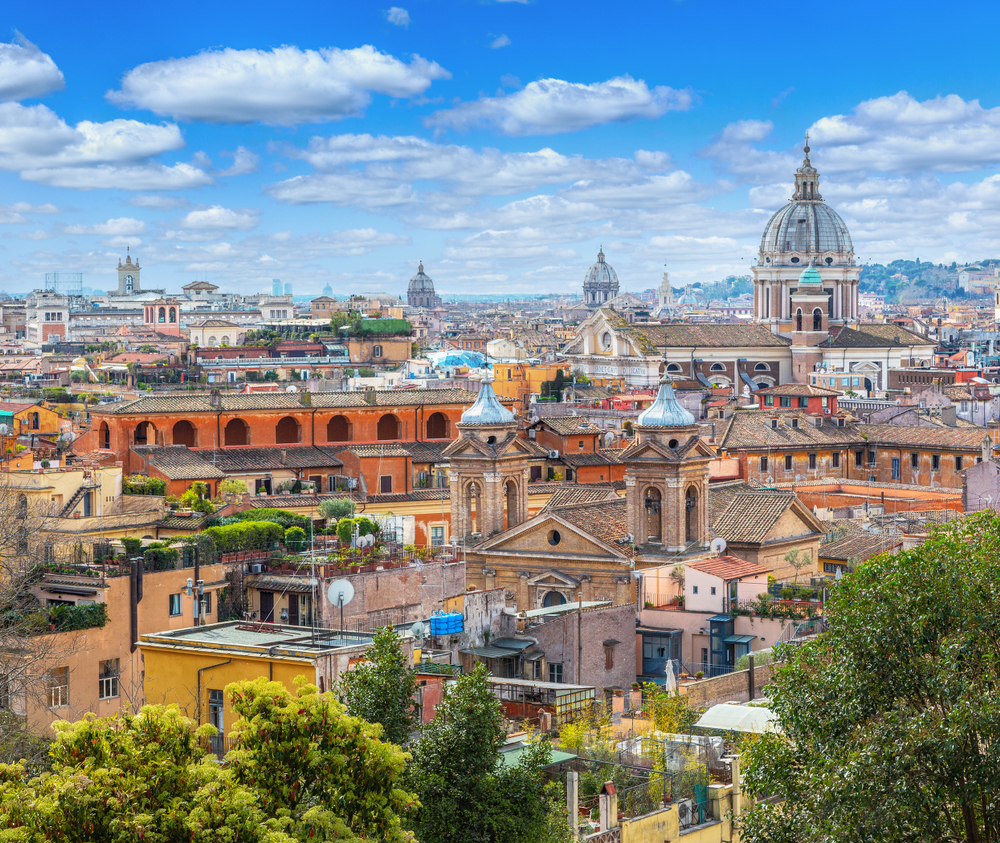
The Pincio Terrace is a scenic overlook located in the Pincio Gardens, adjacent to the Villa Borghese in Rome. This elegant terrace provides stunning panoramic views of the city, including the iconic St. Peter's Basilica, Piazza del Popolo, and the rooftops of Rome's historic centre. The terrace is a popular spot for both tourists and locals to enjoy a leisurely stroll, watch the sunset, or take in the beauty of the Eternal City. Surrounded by lush greenery, statues, and fountains, the Pincio Terrace offers a peaceful retreat and a picturesque vantage point.
- Address: Terrazza del Pincio, Viale dell'Obelisco, 00187 Roma
41. Aventine Hill Belvedere (Orange Garden)
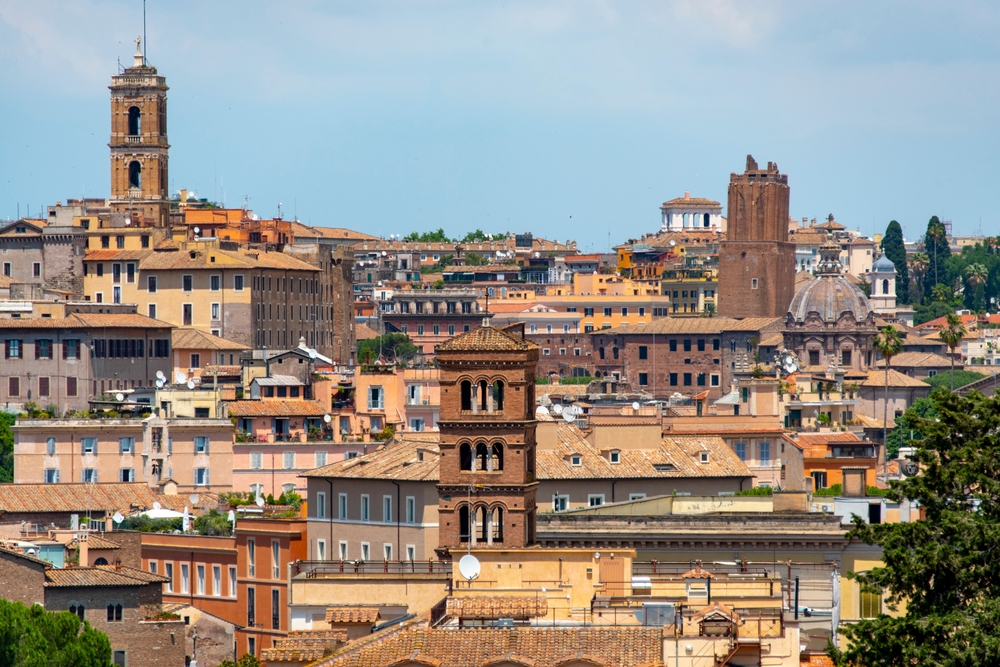
The Aventine Hill Belvedere, also known as the Terrazza Belvedere Aventino, is a tranquil and picturesque viewpoint in Rome that offers stunning panoramic views of the city. Located on the Aventine Hill, the terrace of the beautiful Orange Garden (Giardino degli Aranci) provides a serene setting away from the bustling city centre. Enjoy sweeping vistas of the Tiber River, the dome of St. Peter's Basilica, and the historic skyline of Rome.
- Address: Terrazza Belvedere Aventino, Piazza dei Cavalieri di Malta, 00153 Roma
42. Aventine Keyhole (Il buco di Roma)
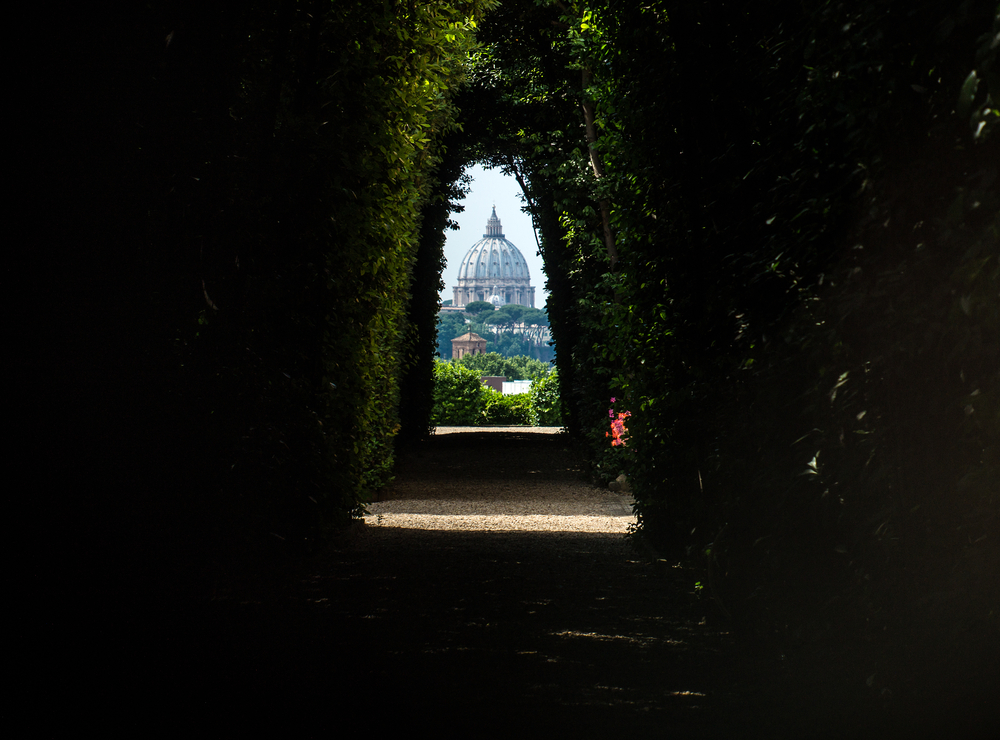
The Aventine keyhole view, known as „il buco di Roma” and found through the gate of the Priory of the Knights of Malta, is a hidden treasure that offers a perfectly framed sight of St. Peter's Basilica. This enchanting keyhole view is aligned with a meticulously manicured garden path, creating a unique and picturesque scene that delights visitors. Located on the tranquil Aventine Hill, this secret spot combines elements of art, architecture, and natural beauty, making it a must-see for those exploring Rome's lesser-known attractions.
- Address: Gran Priorato di Roma dell'Ordine di Malta, Piazza dei Cavalieri di Malta, 3, 00153 Roma
Tours
Exploring Rome by tour is a fantastic way to immerse yourself in the city's rich history, stunning architecture, and vibrant culture. You can conveniently see major landmarks with a hop-on hop-off bus tour, an evening Tiber River cruise, and on a guided walking tour.
43. Hop On Hop Off Bus Tour
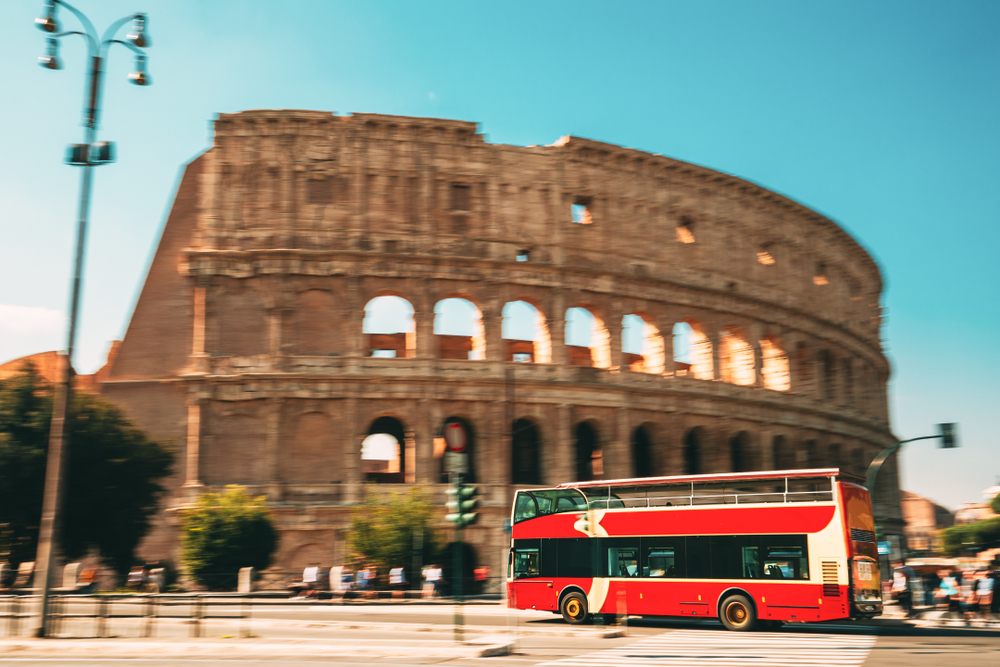
A hop-on hop-off bus tour in Rome offers a convenient and flexible way to explore the city's iconic landmarks. With multiple routes and stops, you can easily get off at any point of interest and rejoin the tour at your leisure. The buses typically provide audio guides in various languages, offering informative commentary about Rome's rich history and culture. Tickets are available for 24, 48, and 72 hours, catering to different travel schedules.
- Address of main stop 1A: Piazza dei Cinquecento (corner Via Cavour), 00185 Roma
44. Evening Tiber River Cruise
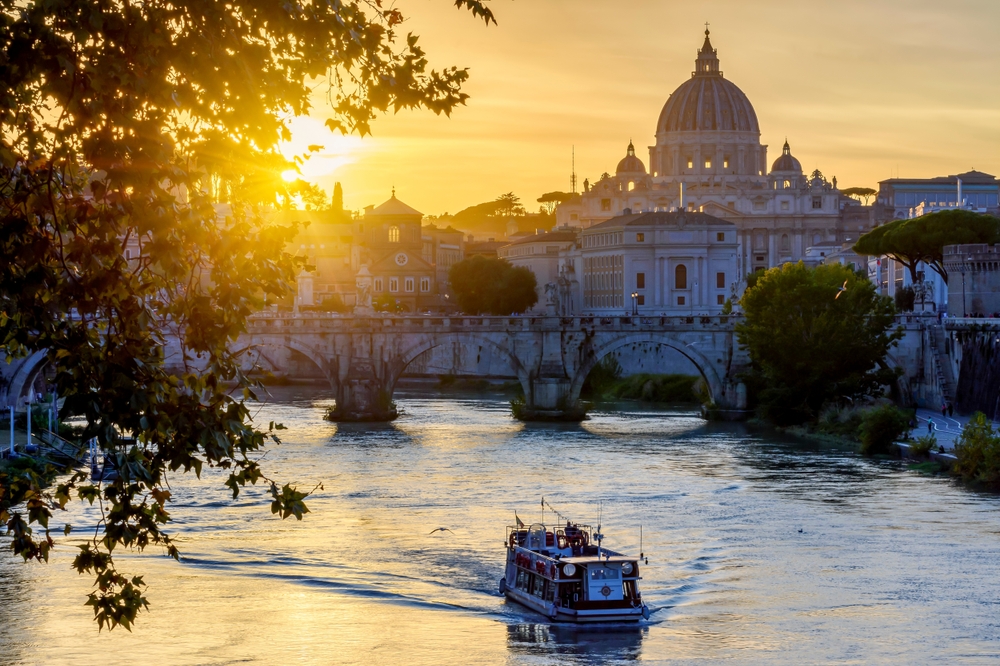
An evening Tiber River cruise offers a unique perspective of Rome's famous sights along the riverbanks. Enjoy a scenic journey while savouring a choice of wine and delicious appetisers. The best part? The ticket also includes a hop-on hop-off tour the next day, providing an extended exploration of the city's highlights.
- Address: Lungotevere Tor di Nona, 00186 Roma
45. Guided Walking Tour

Explore the city of Rome on a guided walking tour with an expert English-speaking guide. See the major attractions in and around central Rome, including the Spanish Steps, Piazza Navona, Trevi Fountain, and the Pantheon. This tour provides an in-depth look at Rome's rich history and vibrant culture, making it an unforgettable experience.
Meeting point: Find the meeting point details on your final voucher
Quarters
Discover the diverse and colourful tapestry of Rome's neighbourhoods, each offering its own unique atmosphere and charm. From historic cobblestone streets to bustling markets and vibrant piazzas, these districts invite exploration and promise unforgettable experiences. Immerse yourself in the local culture, savour authentic cuisine, and uncover hidden gems as you wander through the heart of the Eternal City's dynamic communities.
46. Trastevere

Trastevere, nestled on the west bank of the Tiber River, is a picturesque quarter in Rome brimming with charm and character. Its narrow cobblestone streets are lined with colourful buildings adorned with ivy-covered facades, creating a romantic atmosphere that enchants visitors and locals alike. Quaint trattorias, bustling piazzas, and lively markets dot the neighbourhood, offering a taste of authentic Roman life. Explore hidden alleys, discover ancient churches like the Basilica of Santa Maria in Trastevere Basilica of Santa Maria in Trastevere and the Basilica of Santa Cecilia adorned with stunning mosaics, and soak in the vibrant ambiance.
Trastevere's timeless beauty and bohemian flair make it a beloved destination for travellers seeking an authentic Roman experience. For a panoramic view of the city, head to the Janiculum Hill. Don't miss the eclectic Porta Portese flea market or the historic Palazzo Corsini and Villa Farnesina. Dive into the neighbourhood's rich history at the Sanctuary of San Francesco a Ripa Grande and the Museum of the Roman Republic and Garibaldi Remembrance, or explore the local culture at the Museum of Roma in Trastevere.
47. Testaccio
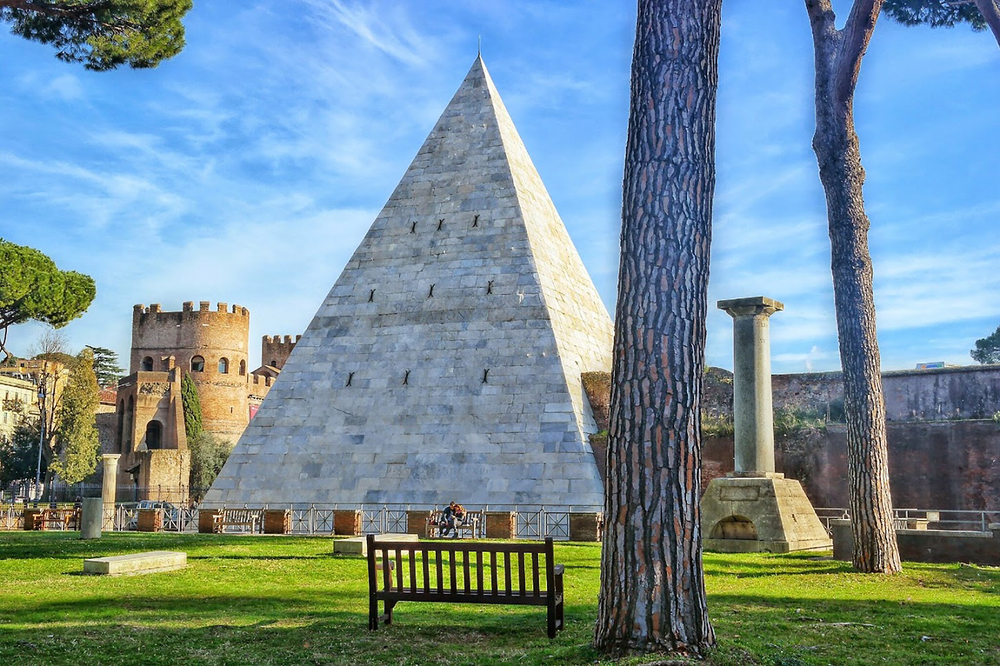
Testaccio embodies the authentic essence of Rome, where locals and visitors converge to experience the city's true spirit. Dive into the bustling trattorias serving up delectable dishes of traditional Roman cuisine, or unwind with friends over cocktails at the vibrant bars that define the Capitoline nightlife scene. Explore the unique landmarks that dot the neighbourhood, such as the iconic Monte dei Cocci, the serene Non-Catholic Cemetery, and the ancient Pyramid of Cestius. Immerse yourself in the rich history and vibrant culture of Testaccio as you wander through its lively streets and discover hidden gems like the historic Emporium. Walk along the banks of the Tiber River to relax and reflect.
With Kids
48. Gladiator School
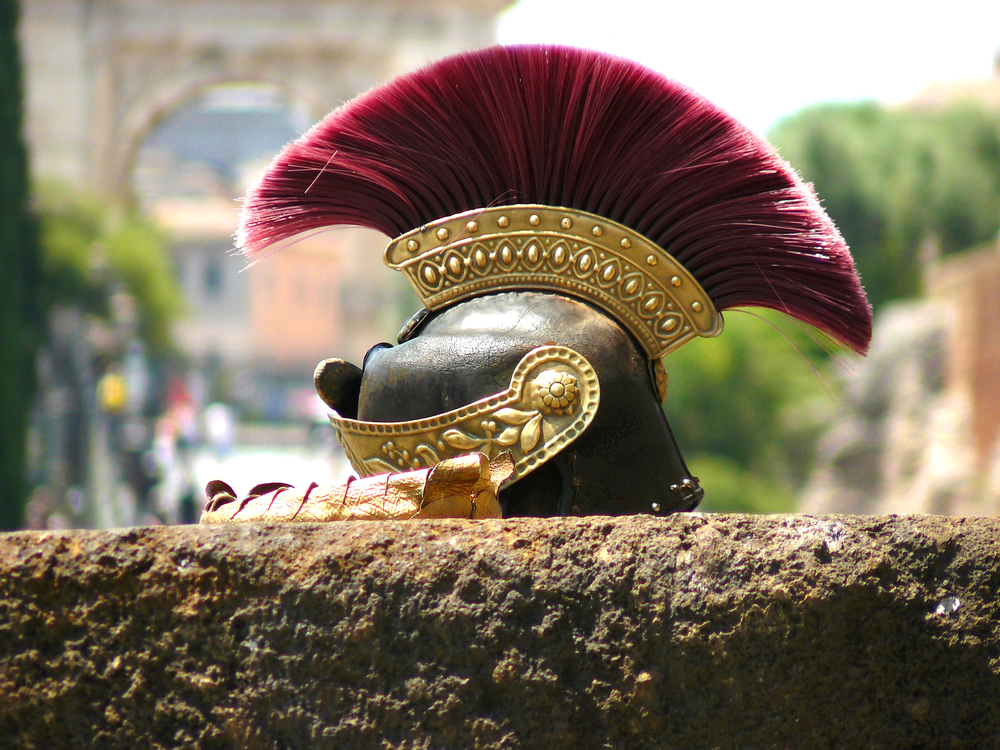
The Gladiator School of Rome offers a unique, interactive experience where kids can dress in traditional gladiator attire and learn combat skills. Located on the ancient Appian Way, the school combines a museum tour with hands-on training sessions led by expert instructors. This engaging activity provides a fun and educational glimpse into Roman history, making it a memorable highlight for families visiting Rome.
- Address: Gladiator School of Rome, Via Appia Antica, 18, 00179 Roma
49. Museum of Illusions
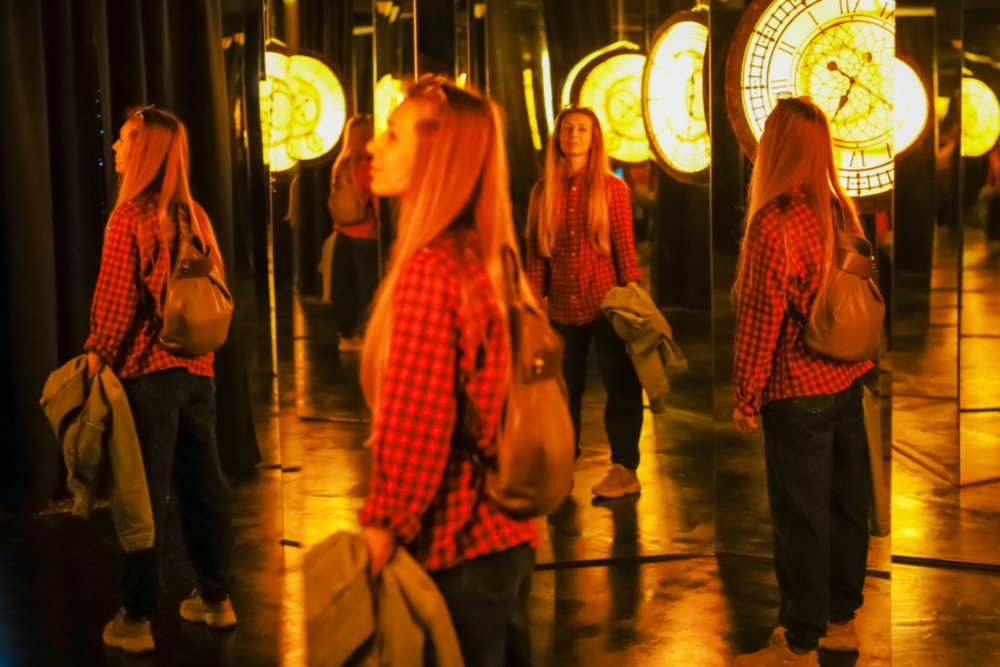
The Museum of Illusions in Rome offers an enchanting experience for visitors of all ages. Step into a world where reality and perception collide, as you explore a variety of mind-bending exhibits and optical illusions. From gravity-defying rooms to perplexing mirror mazes, each exhibit is designed to challenge your senses and leave you in awe. Perfect for families, the museum provides a fun and educational outing, where you can learn about the science behind visual perception while having a blast.
- Address: Museo delle Illusioni Roma, Via Merulana, 17, 00185 Roma
50. VIGAMUS Video Game Museum

VIGAMUS Video Game Museum offers an exciting journey through the history and culture of video games. This immersive museum celebrates the evolution of gaming, from its humble beginnings to the cutting-edge technology of today. Especially your growing family members can explore a vast collection of artefacts, consoles, and memorabilia, spanning decades of gaming history. From classic arcade machines to modern virtual reality experiences, VIGAMUS provides a unique opportunity to discover the impact and significance of video games on society and culture. With interactive exhibits, workshops, and events, the museum offers a dynamic and engaging experience for not only young gamers, but also of all ages.
- Address: VIGAMUS, Via Sabotino, 4, 00195 Roma
